The Future of the Industry 2020 and beyond
VerifiedAdded on 2023/01/19
|23
|5223
|81
AI Summary
This report discusses the future of the industry in 2020 and beyond, focusing on Transport for London (TfL). It explores the innovation requirements and capabilities of TfL, as well as the trends and disruptions in the transportation industry.
Contribute Materials
Your contribution can guide someone’s learning journey. Share your
documents today.
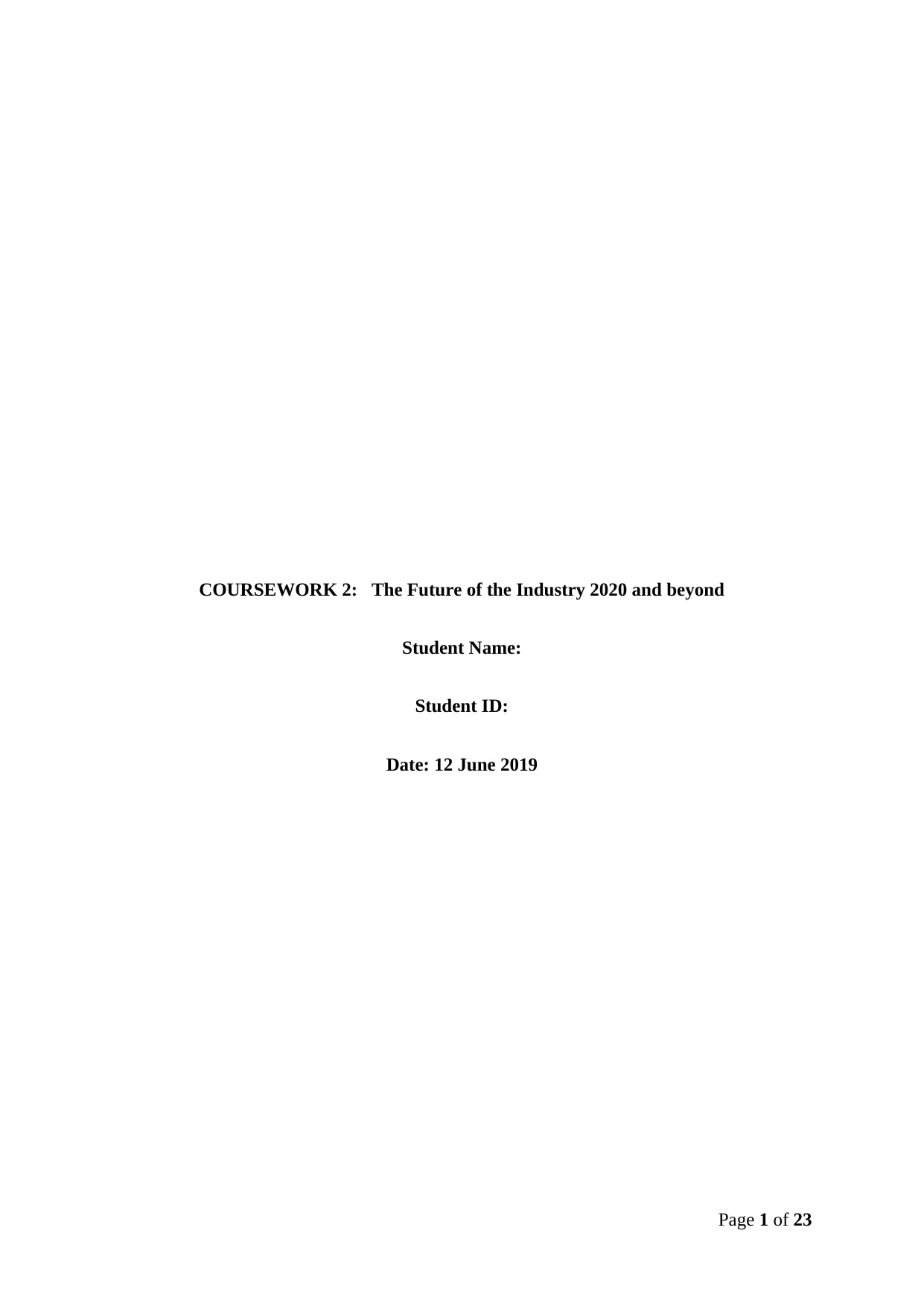
COURSEWORK 2: The Future of the Industry 2020 and beyond
Student Name:
Student ID:
Date: 12 June 2019
Page 1 of 23
Student Name:
Student ID:
Date: 12 June 2019
Page 1 of 23
Secure Best Marks with AI Grader
Need help grading? Try our AI Grader for instant feedback on your assignments.
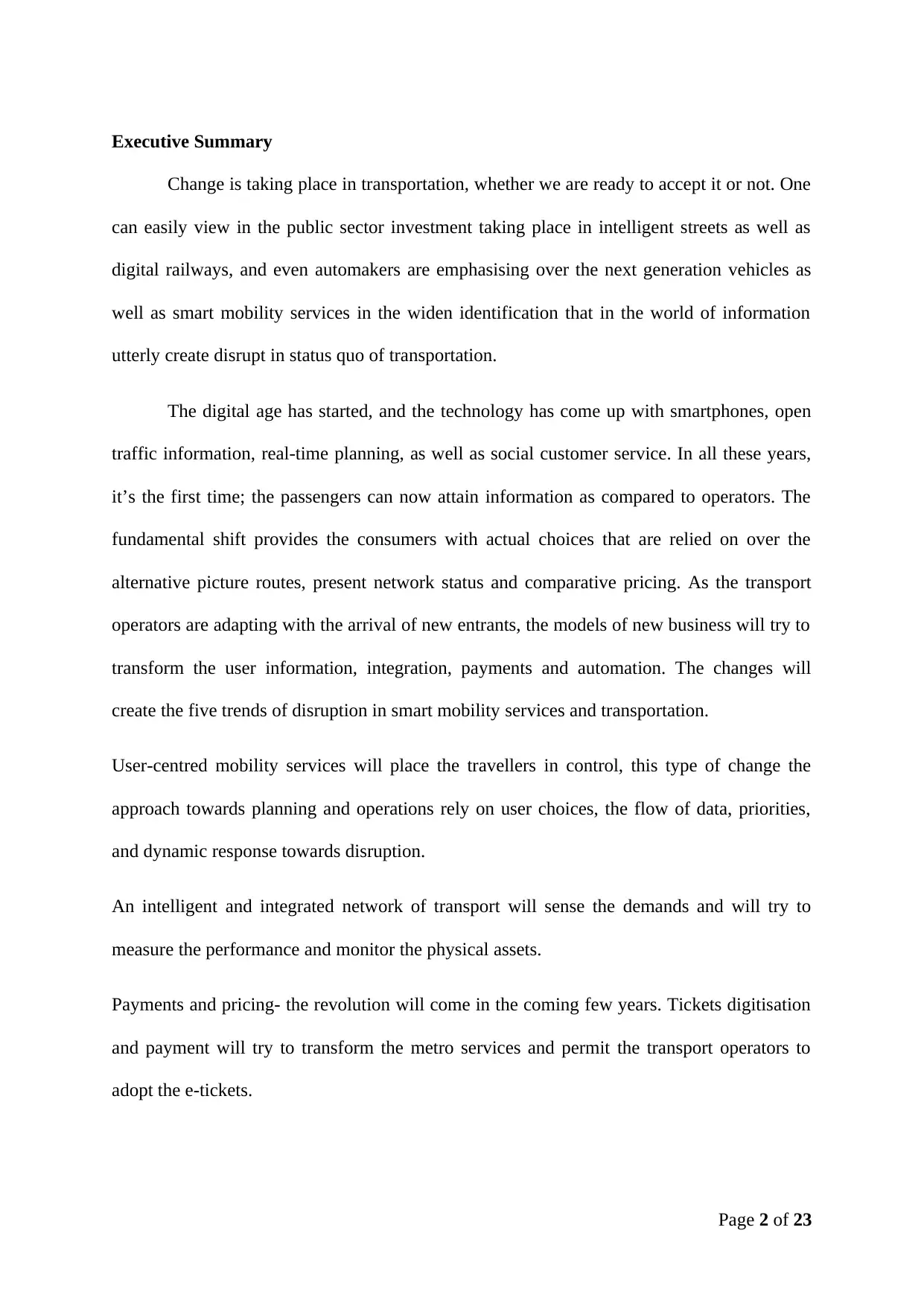
Executive Summary
Change is taking place in transportation, whether we are ready to accept it or not. One
can easily view in the public sector investment taking place in intelligent streets as well as
digital railways, and even automakers are emphasising over the next generation vehicles as
well as smart mobility services in the widen identification that in the world of information
utterly create disrupt in status quo of transportation.
The digital age has started, and the technology has come up with smartphones, open
traffic information, real-time planning, as well as social customer service. In all these years,
it’s the first time; the passengers can now attain information as compared to operators. The
fundamental shift provides the consumers with actual choices that are relied on over the
alternative picture routes, present network status and comparative pricing. As the transport
operators are adapting with the arrival of new entrants, the models of new business will try to
transform the user information, integration, payments and automation. The changes will
create the five trends of disruption in smart mobility services and transportation.
User-centred mobility services will place the travellers in control, this type of change the
approach towards planning and operations rely on user choices, the flow of data, priorities,
and dynamic response towards disruption.
An intelligent and integrated network of transport will sense the demands and will try to
measure the performance and monitor the physical assets.
Payments and pricing- the revolution will come in the coming few years. Tickets digitisation
and payment will try to transform the metro services and permit the transport operators to
adopt the e-tickets.
Page 2 of 23
Change is taking place in transportation, whether we are ready to accept it or not. One
can easily view in the public sector investment taking place in intelligent streets as well as
digital railways, and even automakers are emphasising over the next generation vehicles as
well as smart mobility services in the widen identification that in the world of information
utterly create disrupt in status quo of transportation.
The digital age has started, and the technology has come up with smartphones, open
traffic information, real-time planning, as well as social customer service. In all these years,
it’s the first time; the passengers can now attain information as compared to operators. The
fundamental shift provides the consumers with actual choices that are relied on over the
alternative picture routes, present network status and comparative pricing. As the transport
operators are adapting with the arrival of new entrants, the models of new business will try to
transform the user information, integration, payments and automation. The changes will
create the five trends of disruption in smart mobility services and transportation.
User-centred mobility services will place the travellers in control, this type of change the
approach towards planning and operations rely on user choices, the flow of data, priorities,
and dynamic response towards disruption.
An intelligent and integrated network of transport will sense the demands and will try to
measure the performance and monitor the physical assets.
Payments and pricing- the revolution will come in the coming few years. Tickets digitisation
and payment will try to transform the metro services and permit the transport operators to
adopt the e-tickets.
Page 2 of 23

Safety and automation- it will gain benefit through the exponential cognitive technology
potential to save the life of millions all over the world, especially on roads.
Private and public innovation- it will try to fulfil the challenges of mobility in the 21st
century. The public sector role will be important in stimulating the advances and saving the
citizens.
Page 3 of 23
potential to save the life of millions all over the world, especially on roads.
Private and public innovation- it will try to fulfil the challenges of mobility in the 21st
century. The public sector role will be important in stimulating the advances and saving the
citizens.
Page 3 of 23
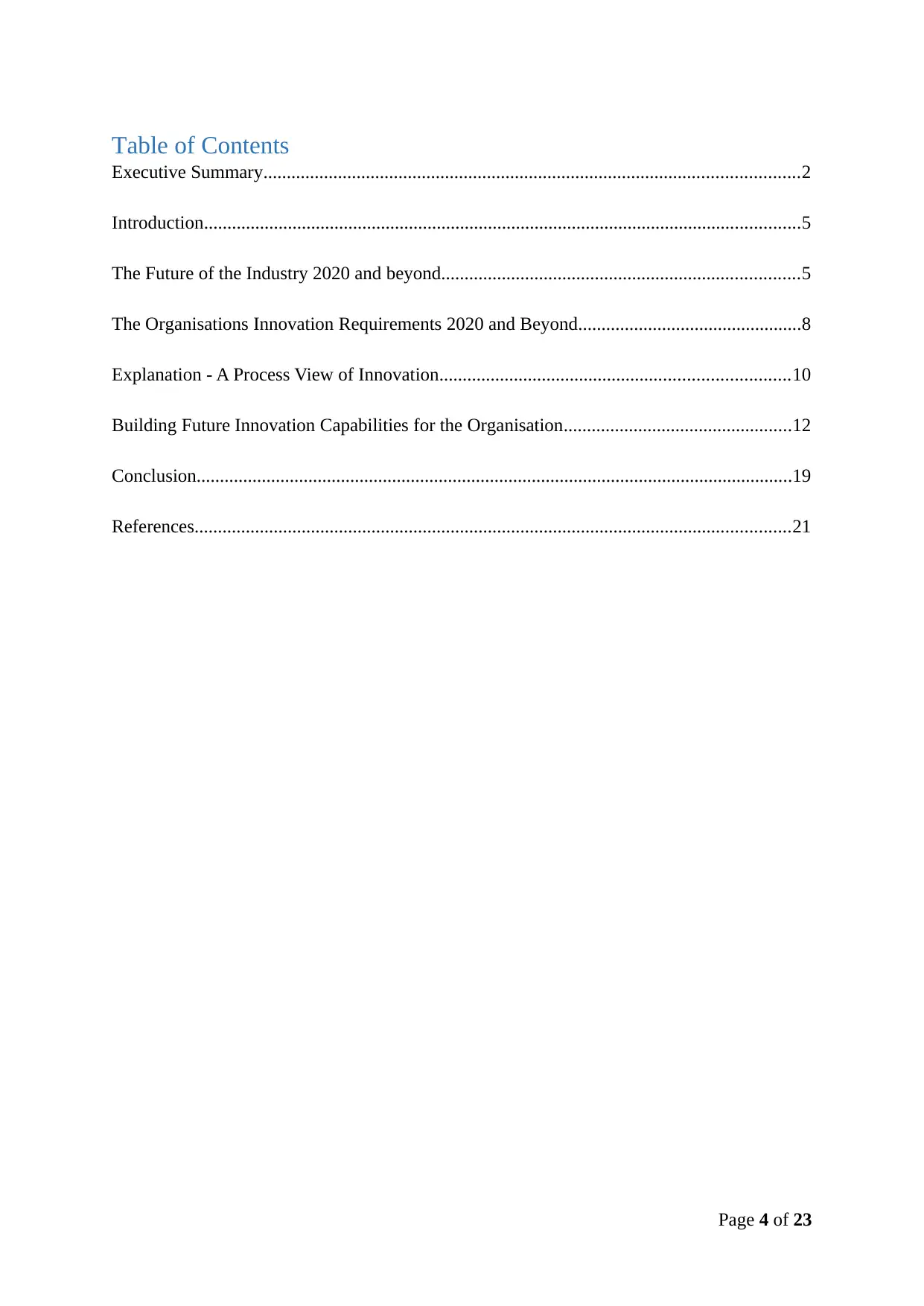
Table of Contents
Executive Summary...................................................................................................................2
Introduction................................................................................................................................5
The Future of the Industry 2020 and beyond.............................................................................5
The Organisations Innovation Requirements 2020 and Beyond................................................8
Explanation - A Process View of Innovation...........................................................................10
Building Future Innovation Capabilities for the Organisation.................................................12
Conclusion................................................................................................................................19
References................................................................................................................................21
Page 4 of 23
Executive Summary...................................................................................................................2
Introduction................................................................................................................................5
The Future of the Industry 2020 and beyond.............................................................................5
The Organisations Innovation Requirements 2020 and Beyond................................................8
Explanation - A Process View of Innovation...........................................................................10
Building Future Innovation Capabilities for the Organisation.................................................12
Conclusion................................................................................................................................19
References................................................................................................................................21
Page 4 of 23
Paraphrase This Document
Need a fresh take? Get an instant paraphrase of this document with our AI Paraphraser

Introduction
There exist no doubt that by 2020, manufacturing taking place in all the industries
will make an investment of billions of dollars in the vast range of advanced fabrication and
digital technologies (Christensen, Raynor and McDonald, 2015). It includes the 3D Nano-
manufacturing and printing technology, along with the new capabilities, which are ushered
through the massive use of Internet-connected analytics and sensors. Decisions are taken over
where the next place to invest, will rely on the leadership objectives and priorities that are
highly subject towards the market forecasts and conditions. Each new equipment of capital
investment is highly subject towards the cost/benefit analysis (Christensen, Raynor and
McDonald, 2015). The analysis outcome and the decision timing is variant in every industry,
factory or organisations.
This report will discuss the future of the industry in 2020 and beyond it. The report
will consider Transport for London (TfL) for analysing the future of the transport industry.
This report will also explain the innovation requirements of the industry and future
innovation capabilities of TfL.
The Future of the Industry 2020 and beyond
Future of Transport for London (TfL)
The international transport industry is going to enter in the era of enormous range as
well as transformative changes, as the sales will get shifted and the environmental regulations
will get tighten up. The organisations who are interested in becoming successful in the long
run will require to achieve critical strategic decisions in the coming decade (Christensen,
Raynor and McDonald, 2015).
Page 5 of 23
There exist no doubt that by 2020, manufacturing taking place in all the industries
will make an investment of billions of dollars in the vast range of advanced fabrication and
digital technologies (Christensen, Raynor and McDonald, 2015). It includes the 3D Nano-
manufacturing and printing technology, along with the new capabilities, which are ushered
through the massive use of Internet-connected analytics and sensors. Decisions are taken over
where the next place to invest, will rely on the leadership objectives and priorities that are
highly subject towards the market forecasts and conditions. Each new equipment of capital
investment is highly subject towards the cost/benefit analysis (Christensen, Raynor and
McDonald, 2015). The analysis outcome and the decision timing is variant in every industry,
factory or organisations.
This report will discuss the future of the industry in 2020 and beyond it. The report
will consider Transport for London (TfL) for analysing the future of the transport industry.
This report will also explain the innovation requirements of the industry and future
innovation capabilities of TfL.
The Future of the Industry 2020 and beyond
Future of Transport for London (TfL)
The international transport industry is going to enter in the era of enormous range as
well as transformative changes, as the sales will get shifted and the environmental regulations
will get tighten up. The organisations who are interested in becoming successful in the long
run will require to achieve critical strategic decisions in the coming decade (Christensen,
Raynor and McDonald, 2015).
Page 5 of 23
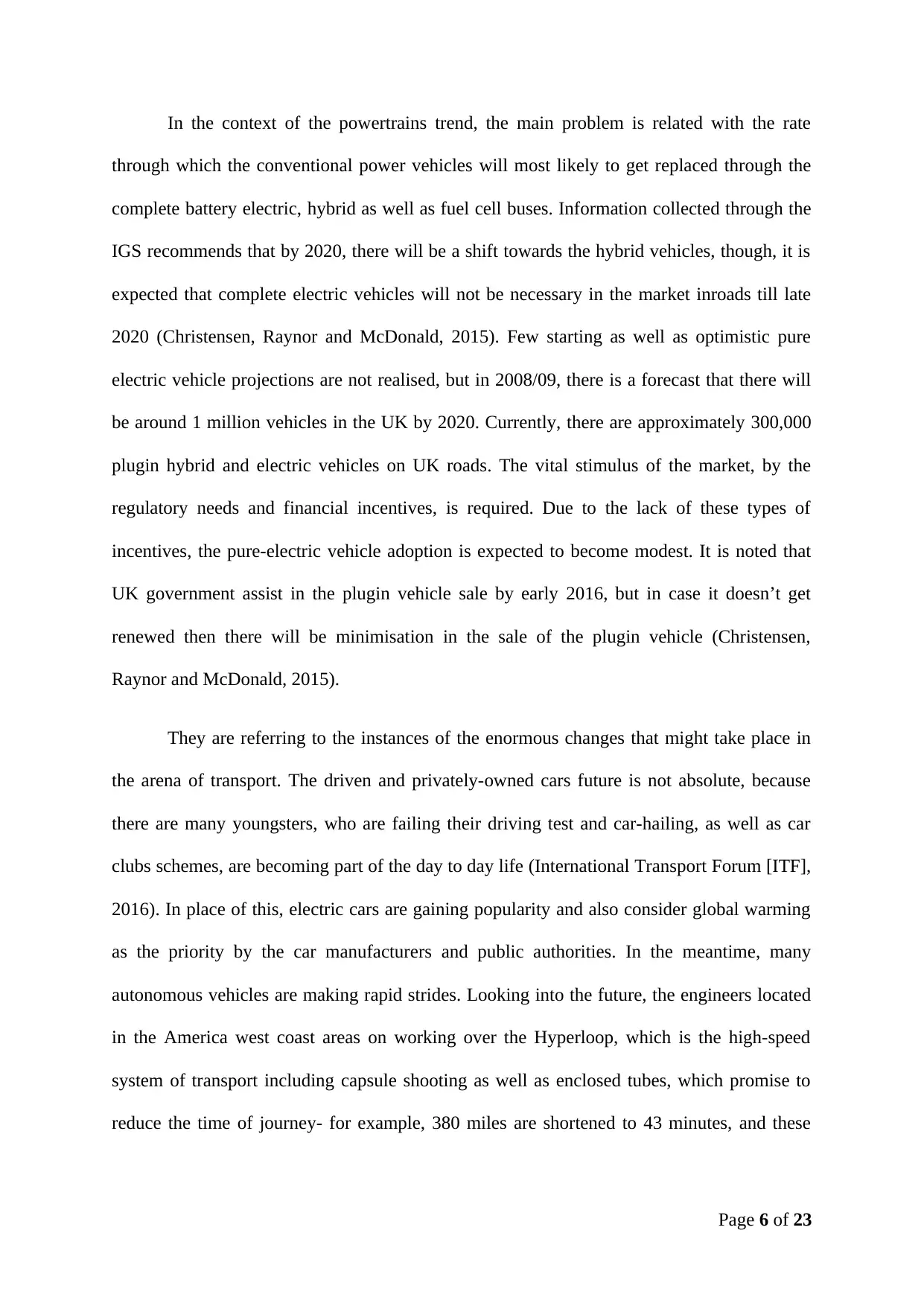
In the context of the powertrains trend, the main problem is related with the rate
through which the conventional power vehicles will most likely to get replaced through the
complete battery electric, hybrid as well as fuel cell buses. Information collected through the
IGS recommends that by 2020, there will be a shift towards the hybrid vehicles, though, it is
expected that complete electric vehicles will not be necessary in the market inroads till late
2020 (Christensen, Raynor and McDonald, 2015). Few starting as well as optimistic pure
electric vehicle projections are not realised, but in 2008/09, there is a forecast that there will
be around 1 million vehicles in the UK by 2020. Currently, there are approximately 300,000
plugin hybrid and electric vehicles on UK roads. The vital stimulus of the market, by the
regulatory needs and financial incentives, is required. Due to the lack of these types of
incentives, the pure-electric vehicle adoption is expected to become modest. It is noted that
UK government assist in the plugin vehicle sale by early 2016, but in case it doesn’t get
renewed then there will be minimisation in the sale of the plugin vehicle (Christensen,
Raynor and McDonald, 2015).
They are referring to the instances of the enormous changes that might take place in
the arena of transport. The driven and privately-owned cars future is not absolute, because
there are many youngsters, who are failing their driving test and car-hailing, as well as car
clubs schemes, are becoming part of the day to day life (International Transport Forum [ITF],
2016). In place of this, electric cars are gaining popularity and also consider global warming
as the priority by the car manufacturers and public authorities. In the meantime, many
autonomous vehicles are making rapid strides. Looking into the future, the engineers located
in the America west coast areas on working over the Hyperloop, which is the high-speed
system of transport including capsule shooting as well as enclosed tubes, which promise to
reduce the time of journey- for example, 380 miles are shortened to 43 minutes, and these
Page 6 of 23
through which the conventional power vehicles will most likely to get replaced through the
complete battery electric, hybrid as well as fuel cell buses. Information collected through the
IGS recommends that by 2020, there will be a shift towards the hybrid vehicles, though, it is
expected that complete electric vehicles will not be necessary in the market inroads till late
2020 (Christensen, Raynor and McDonald, 2015). Few starting as well as optimistic pure
electric vehicle projections are not realised, but in 2008/09, there is a forecast that there will
be around 1 million vehicles in the UK by 2020. Currently, there are approximately 300,000
plugin hybrid and electric vehicles on UK roads. The vital stimulus of the market, by the
regulatory needs and financial incentives, is required. Due to the lack of these types of
incentives, the pure-electric vehicle adoption is expected to become modest. It is noted that
UK government assist in the plugin vehicle sale by early 2016, but in case it doesn’t get
renewed then there will be minimisation in the sale of the plugin vehicle (Christensen,
Raynor and McDonald, 2015).
They are referring to the instances of the enormous changes that might take place in
the arena of transport. The driven and privately-owned cars future is not absolute, because
there are many youngsters, who are failing their driving test and car-hailing, as well as car
clubs schemes, are becoming part of the day to day life (International Transport Forum [ITF],
2016). In place of this, electric cars are gaining popularity and also consider global warming
as the priority by the car manufacturers and public authorities. In the meantime, many
autonomous vehicles are making rapid strides. Looking into the future, the engineers located
in the America west coast areas on working over the Hyperloop, which is the high-speed
system of transport including capsule shooting as well as enclosed tubes, which promise to
reduce the time of journey- for example, 380 miles are shortened to 43 minutes, and these
Page 6 of 23
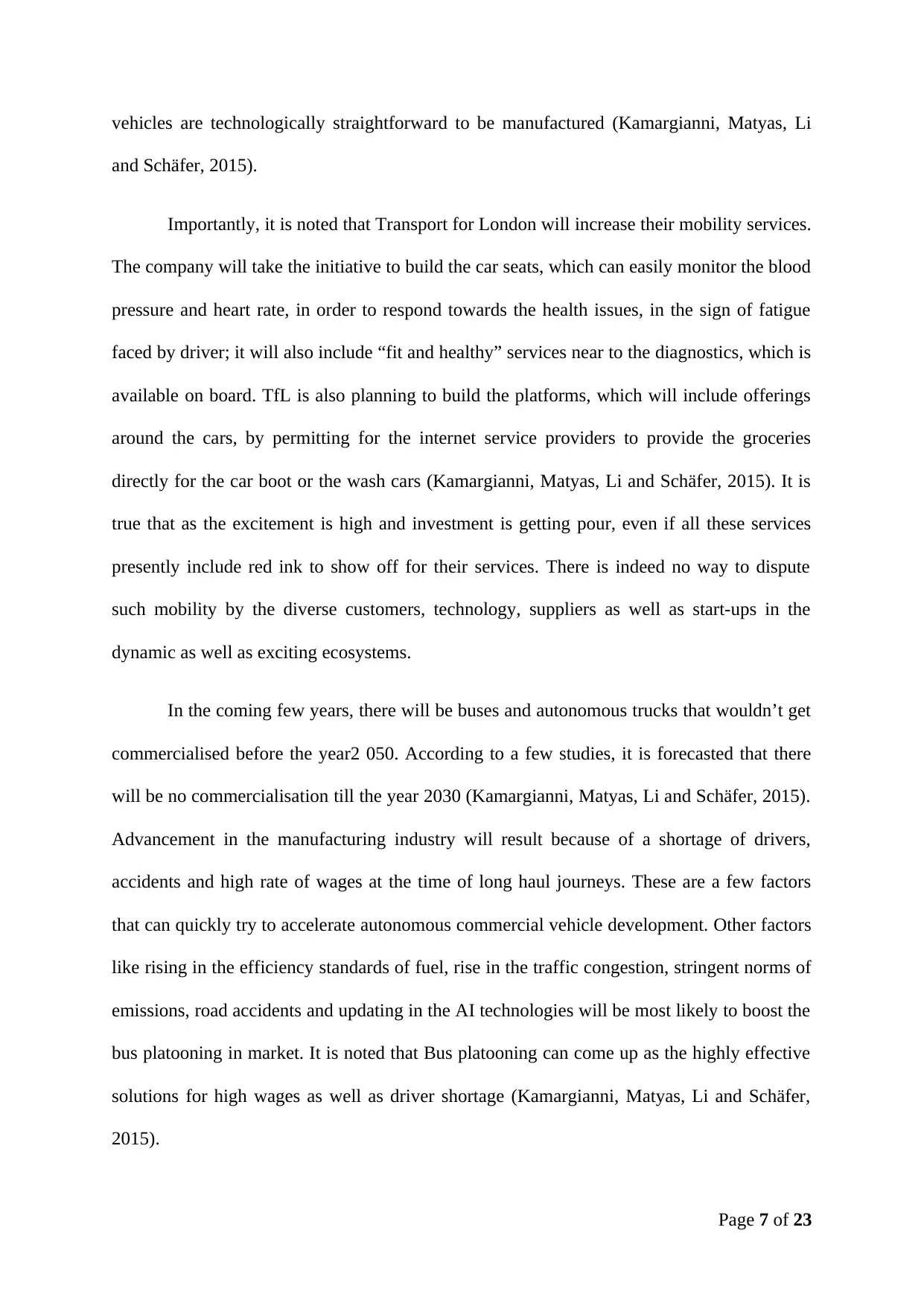
vehicles are technologically straightforward to be manufactured (Kamargianni, Matyas, Li
and Schäfer, 2015).
Importantly, it is noted that Transport for London will increase their mobility services.
The company will take the initiative to build the car seats, which can easily monitor the blood
pressure and heart rate, in order to respond towards the health issues, in the sign of fatigue
faced by driver; it will also include “fit and healthy” services near to the diagnostics, which is
available on board. TfL is also planning to build the platforms, which will include offerings
around the cars, by permitting for the internet service providers to provide the groceries
directly for the car boot or the wash cars (Kamargianni, Matyas, Li and Schäfer, 2015). It is
true that as the excitement is high and investment is getting pour, even if all these services
presently include red ink to show off for their services. There is indeed no way to dispute
such mobility by the diverse customers, technology, suppliers as well as start-ups in the
dynamic as well as exciting ecosystems.
In the coming few years, there will be buses and autonomous trucks that wouldn’t get
commercialised before the year2 050. According to a few studies, it is forecasted that there
will be no commercialisation till the year 2030 (Kamargianni, Matyas, Li and Schäfer, 2015).
Advancement in the manufacturing industry will result because of a shortage of drivers,
accidents and high rate of wages at the time of long haul journeys. These are a few factors
that can quickly try to accelerate autonomous commercial vehicle development. Other factors
like rising in the efficiency standards of fuel, rise in the traffic congestion, stringent norms of
emissions, road accidents and updating in the AI technologies will be most likely to boost the
bus platooning in market. It is noted that Bus platooning can come up as the highly effective
solutions for high wages as well as driver shortage (Kamargianni, Matyas, Li and Schäfer,
2015).
Page 7 of 23
and Schäfer, 2015).
Importantly, it is noted that Transport for London will increase their mobility services.
The company will take the initiative to build the car seats, which can easily monitor the blood
pressure and heart rate, in order to respond towards the health issues, in the sign of fatigue
faced by driver; it will also include “fit and healthy” services near to the diagnostics, which is
available on board. TfL is also planning to build the platforms, which will include offerings
around the cars, by permitting for the internet service providers to provide the groceries
directly for the car boot or the wash cars (Kamargianni, Matyas, Li and Schäfer, 2015). It is
true that as the excitement is high and investment is getting pour, even if all these services
presently include red ink to show off for their services. There is indeed no way to dispute
such mobility by the diverse customers, technology, suppliers as well as start-ups in the
dynamic as well as exciting ecosystems.
In the coming few years, there will be buses and autonomous trucks that wouldn’t get
commercialised before the year2 050. According to a few studies, it is forecasted that there
will be no commercialisation till the year 2030 (Kamargianni, Matyas, Li and Schäfer, 2015).
Advancement in the manufacturing industry will result because of a shortage of drivers,
accidents and high rate of wages at the time of long haul journeys. These are a few factors
that can quickly try to accelerate autonomous commercial vehicle development. Other factors
like rising in the efficiency standards of fuel, rise in the traffic congestion, stringent norms of
emissions, road accidents and updating in the AI technologies will be most likely to boost the
bus platooning in market. It is noted that Bus platooning can come up as the highly effective
solutions for high wages as well as driver shortage (Kamargianni, Matyas, Li and Schäfer,
2015).
Page 7 of 23
Secure Best Marks with AI Grader
Need help grading? Try our AI Grader for instant feedback on your assignments.
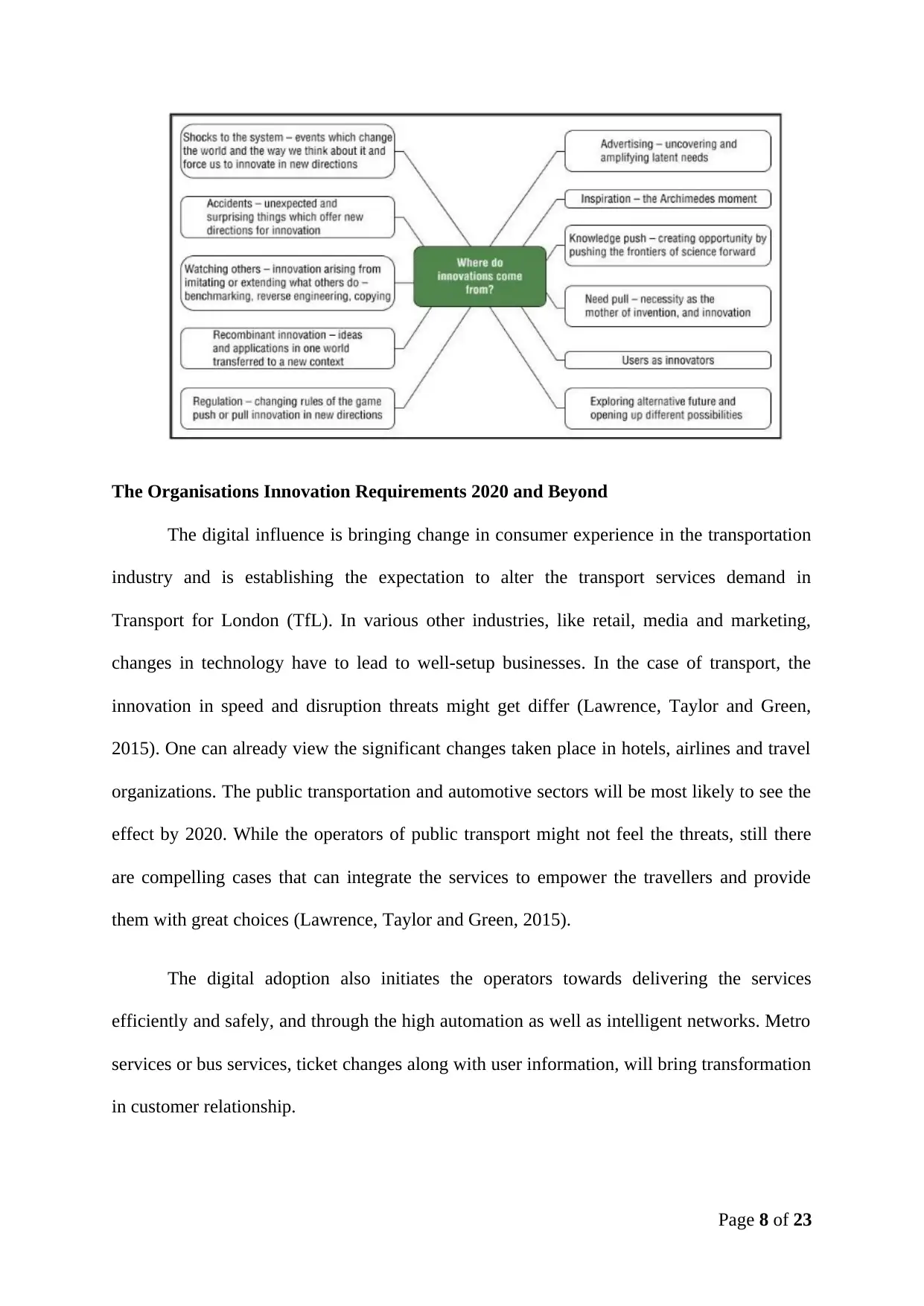
The Organisations Innovation Requirements 2020 and Beyond
The digital influence is bringing change in consumer experience in the transportation
industry and is establishing the expectation to alter the transport services demand in
Transport for London (TfL). In various other industries, like retail, media and marketing,
changes in technology have to lead to well-setup businesses. In the case of transport, the
innovation in speed and disruption threats might get differ (Lawrence, Taylor and Green,
2015). One can already view the significant changes taken place in hotels, airlines and travel
organizations. The public transportation and automotive sectors will be most likely to see the
effect by 2020. While the operators of public transport might not feel the threats, still there
are compelling cases that can integrate the services to empower the travellers and provide
them with great choices (Lawrence, Taylor and Green, 2015).
The digital adoption also initiates the operators towards delivering the services
efficiently and safely, and through the high automation as well as intelligent networks. Metro
services or bus services, ticket changes along with user information, will bring transformation
in customer relationship.
Page 8 of 23
The digital influence is bringing change in consumer experience in the transportation
industry and is establishing the expectation to alter the transport services demand in
Transport for London (TfL). In various other industries, like retail, media and marketing,
changes in technology have to lead to well-setup businesses. In the case of transport, the
innovation in speed and disruption threats might get differ (Lawrence, Taylor and Green,
2015). One can already view the significant changes taken place in hotels, airlines and travel
organizations. The public transportation and automotive sectors will be most likely to see the
effect by 2020. While the operators of public transport might not feel the threats, still there
are compelling cases that can integrate the services to empower the travellers and provide
them with great choices (Lawrence, Taylor and Green, 2015).
The digital adoption also initiates the operators towards delivering the services
efficiently and safely, and through the high automation as well as intelligent networks. Metro
services or bus services, ticket changes along with user information, will bring transformation
in customer relationship.
Page 8 of 23
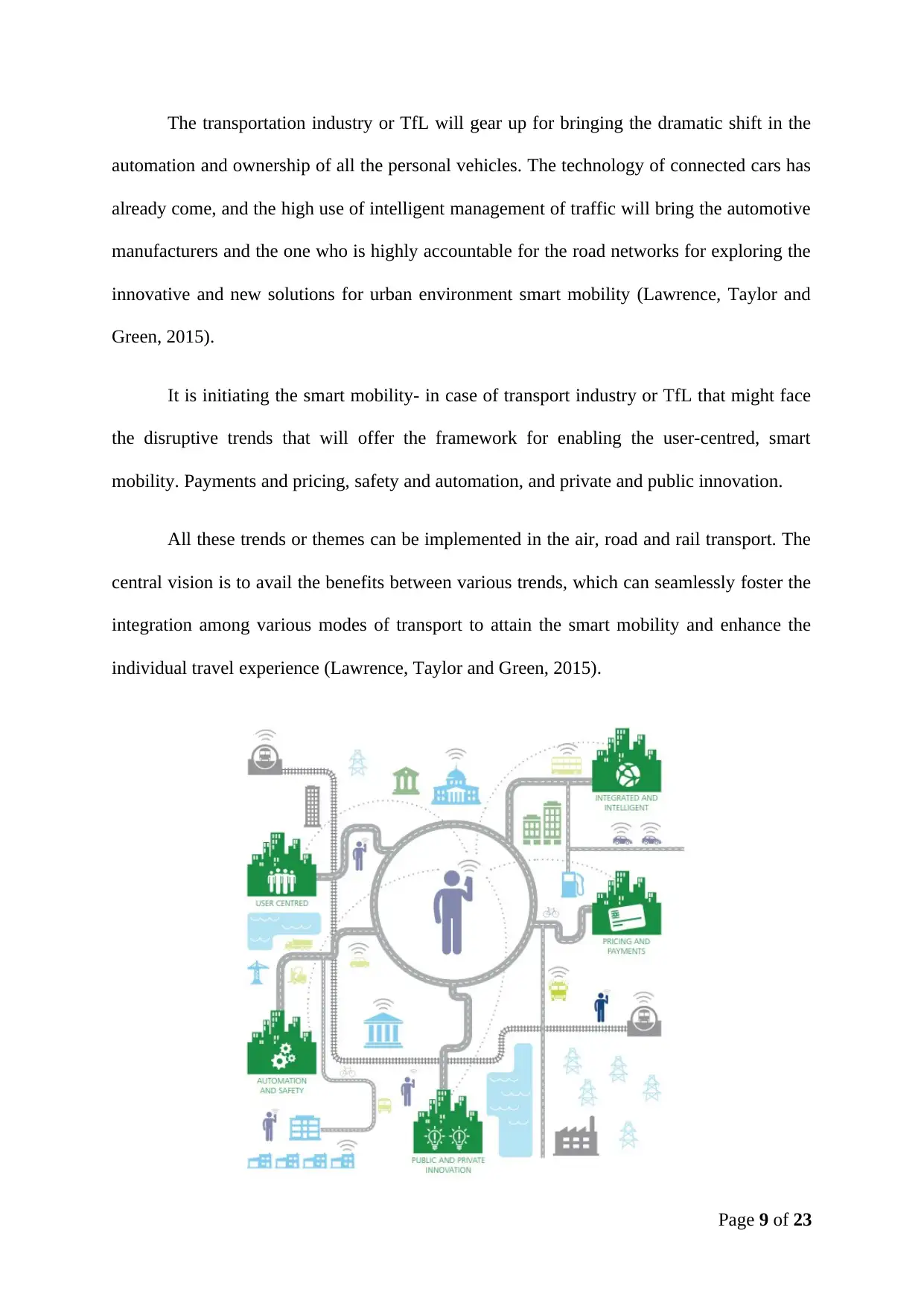
The transportation industry or TfL will gear up for bringing the dramatic shift in the
automation and ownership of all the personal vehicles. The technology of connected cars has
already come, and the high use of intelligent management of traffic will bring the automotive
manufacturers and the one who is highly accountable for the road networks for exploring the
innovative and new solutions for urban environment smart mobility (Lawrence, Taylor and
Green, 2015).
It is initiating the smart mobility- in case of transport industry or TfL that might face
the disruptive trends that will offer the framework for enabling the user-centred, smart
mobility. Payments and pricing, safety and automation, and private and public innovation.
All these trends or themes can be implemented in the air, road and rail transport. The
central vision is to avail the benefits between various trends, which can seamlessly foster the
integration among various modes of transport to attain the smart mobility and enhance the
individual travel experience (Lawrence, Taylor and Green, 2015).
Page 9 of 23
automation and ownership of all the personal vehicles. The technology of connected cars has
already come, and the high use of intelligent management of traffic will bring the automotive
manufacturers and the one who is highly accountable for the road networks for exploring the
innovative and new solutions for urban environment smart mobility (Lawrence, Taylor and
Green, 2015).
It is initiating the smart mobility- in case of transport industry or TfL that might face
the disruptive trends that will offer the framework for enabling the user-centred, smart
mobility. Payments and pricing, safety and automation, and private and public innovation.
All these trends or themes can be implemented in the air, road and rail transport. The
central vision is to avail the benefits between various trends, which can seamlessly foster the
integration among various modes of transport to attain the smart mobility and enhance the
individual travel experience (Lawrence, Taylor and Green, 2015).
Page 9 of 23
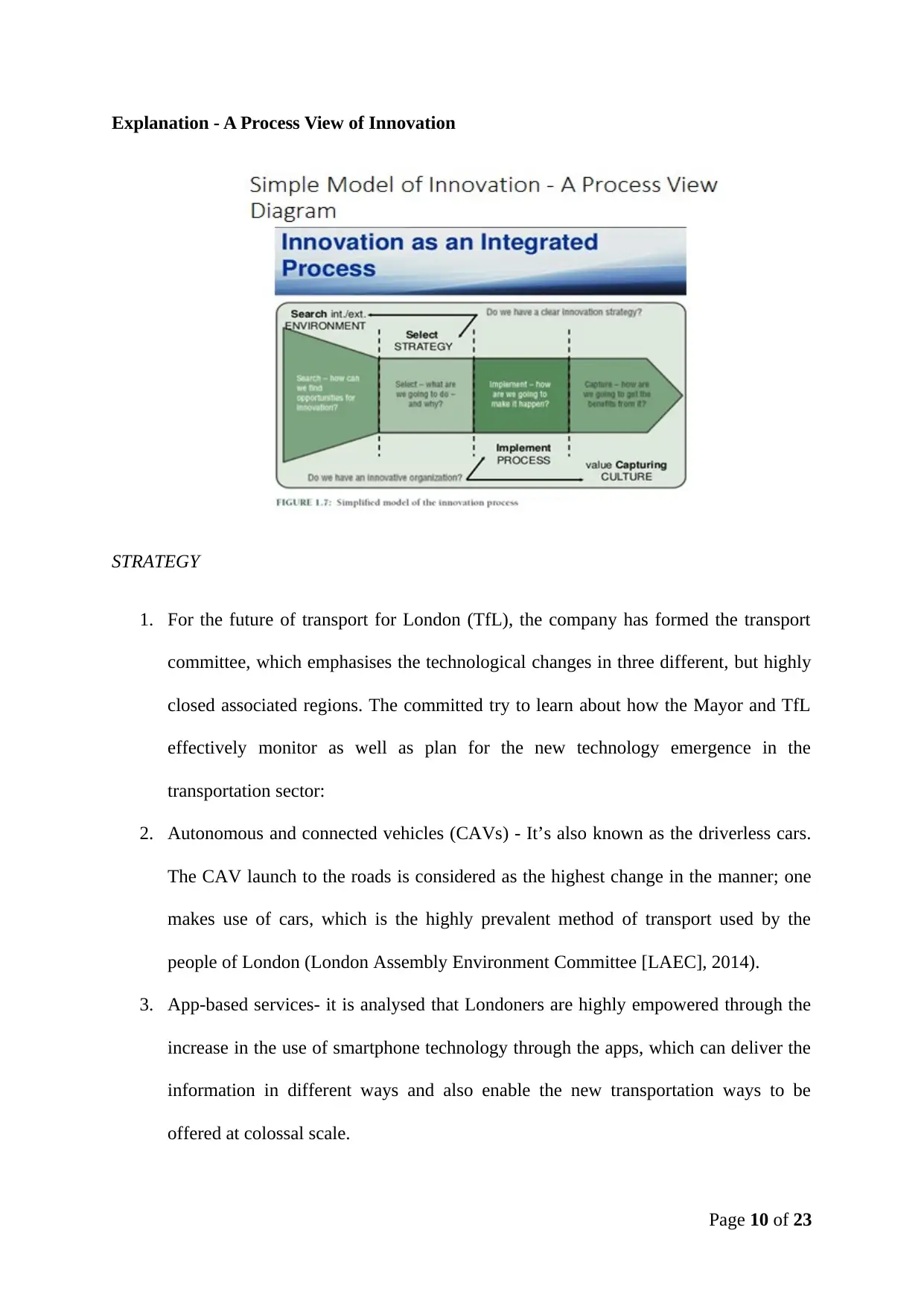
Explanation - A Process View of Innovation
STRATEGY
1. For the future of transport for London (TfL), the company has formed the transport
committee, which emphasises the technological changes in three different, but highly
closed associated regions. The committed try to learn about how the Mayor and TfL
effectively monitor as well as plan for the new technology emergence in the
transportation sector:
2. Autonomous and connected vehicles (CAVs) - It’s also known as the driverless cars.
The CAV launch to the roads is considered as the highest change in the manner; one
makes use of cars, which is the highly prevalent method of transport used by the
people of London (London Assembly Environment Committee [LAEC], 2014).
3. App-based services- it is analysed that Londoners are highly empowered through the
increase in the use of smartphone technology through the apps, which can deliver the
information in different ways and also enable the new transportation ways to be
offered at colossal scale.
Page 10 of 23
STRATEGY
1. For the future of transport for London (TfL), the company has formed the transport
committee, which emphasises the technological changes in three different, but highly
closed associated regions. The committed try to learn about how the Mayor and TfL
effectively monitor as well as plan for the new technology emergence in the
transportation sector:
2. Autonomous and connected vehicles (CAVs) - It’s also known as the driverless cars.
The CAV launch to the roads is considered as the highest change in the manner; one
makes use of cars, which is the highly prevalent method of transport used by the
people of London (London Assembly Environment Committee [LAEC], 2014).
3. App-based services- it is analysed that Londoners are highly empowered through the
increase in the use of smartphone technology through the apps, which can deliver the
information in different ways and also enable the new transportation ways to be
offered at colossal scale.
Page 10 of 23
Paraphrase This Document
Need a fresh take? Get an instant paraphrase of this document with our AI Paraphraser
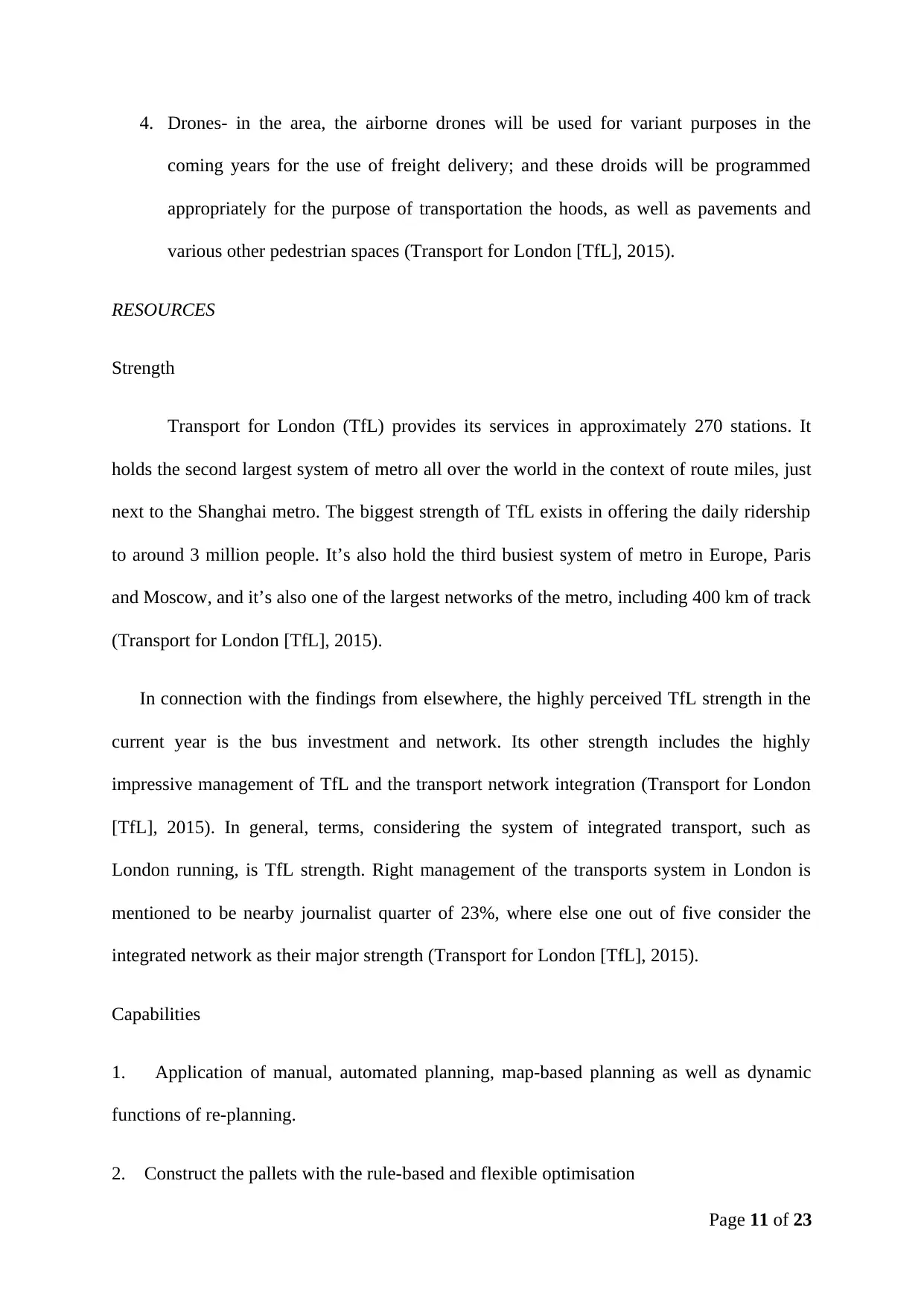
4. Drones- in the area, the airborne drones will be used for variant purposes in the
coming years for the use of freight delivery; and these droids will be programmed
appropriately for the purpose of transportation the hoods, as well as pavements and
various other pedestrian spaces (Transport for London [TfL], 2015).
RESOURCES
Strength
Transport for London (TfL) provides its services in approximately 270 stations. It
holds the second largest system of metro all over the world in the context of route miles, just
next to the Shanghai metro. The biggest strength of TfL exists in offering the daily ridership
to around 3 million people. It’s also hold the third busiest system of metro in Europe, Paris
and Moscow, and it’s also one of the largest networks of the metro, including 400 km of track
(Transport for London [TfL], 2015).
In connection with the findings from elsewhere, the highly perceived TfL strength in the
current year is the bus investment and network. Its other strength includes the highly
impressive management of TfL and the transport network integration (Transport for London
[TfL], 2015). In general, terms, considering the system of integrated transport, such as
London running, is TfL strength. Right management of the transports system in London is
mentioned to be nearby journalist quarter of 23%, where else one out of five consider the
integrated network as their major strength (Transport for London [TfL], 2015).
Capabilities
1. Application of manual, automated planning, map-based planning as well as dynamic
functions of re-planning.
2. Construct the pallets with the rule-based and flexible optimisation
Page 11 of 23
coming years for the use of freight delivery; and these droids will be programmed
appropriately for the purpose of transportation the hoods, as well as pavements and
various other pedestrian spaces (Transport for London [TfL], 2015).
RESOURCES
Strength
Transport for London (TfL) provides its services in approximately 270 stations. It
holds the second largest system of metro all over the world in the context of route miles, just
next to the Shanghai metro. The biggest strength of TfL exists in offering the daily ridership
to around 3 million people. It’s also hold the third busiest system of metro in Europe, Paris
and Moscow, and it’s also one of the largest networks of the metro, including 400 km of track
(Transport for London [TfL], 2015).
In connection with the findings from elsewhere, the highly perceived TfL strength in the
current year is the bus investment and network. Its other strength includes the highly
impressive management of TfL and the transport network integration (Transport for London
[TfL], 2015). In general, terms, considering the system of integrated transport, such as
London running, is TfL strength. Right management of the transports system in London is
mentioned to be nearby journalist quarter of 23%, where else one out of five consider the
integrated network as their major strength (Transport for London [TfL], 2015).
Capabilities
1. Application of manual, automated planning, map-based planning as well as dynamic
functions of re-planning.
2. Construct the pallets with the rule-based and flexible optimisation
Page 11 of 23
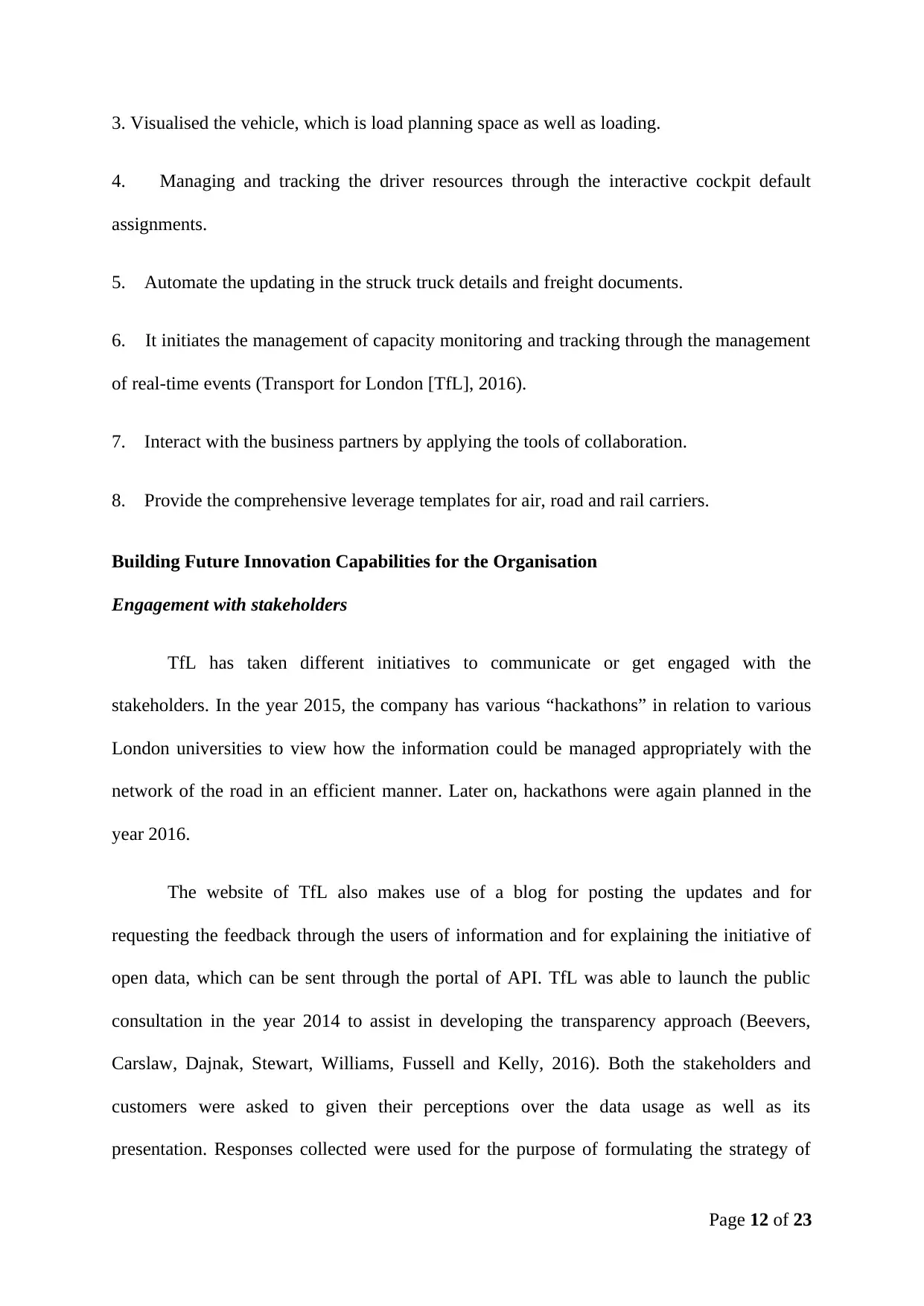
3. Visualised the vehicle, which is load planning space as well as loading.
4. Managing and tracking the driver resources through the interactive cockpit default
assignments.
5. Automate the updating in the struck truck details and freight documents.
6. It initiates the management of capacity monitoring and tracking through the management
of real-time events (Transport for London [TfL], 2016).
7. Interact with the business partners by applying the tools of collaboration.
8. Provide the comprehensive leverage templates for air, road and rail carriers.
Building Future Innovation Capabilities for the Organisation
Engagement with stakeholders
TfL has taken different initiatives to communicate or get engaged with the
stakeholders. In the year 2015, the company has various “hackathons” in relation to various
London universities to view how the information could be managed appropriately with the
network of the road in an efficient manner. Later on, hackathons were again planned in the
year 2016.
The website of TfL also makes use of a blog for posting the updates and for
requesting the feedback through the users of information and for explaining the initiative of
open data, which can be sent through the portal of API. TfL was able to launch the public
consultation in the year 2014 to assist in developing the transparency approach (Beevers,
Carslaw, Dajnak, Stewart, Williams, Fussell and Kelly, 2016). Both the stakeholders and
customers were asked to given their perceptions over the data usage as well as its
presentation. Responses collected were used for the purpose of formulating the strategy of
Page 12 of 23
4. Managing and tracking the driver resources through the interactive cockpit default
assignments.
5. Automate the updating in the struck truck details and freight documents.
6. It initiates the management of capacity monitoring and tracking through the management
of real-time events (Transport for London [TfL], 2016).
7. Interact with the business partners by applying the tools of collaboration.
8. Provide the comprehensive leverage templates for air, road and rail carriers.
Building Future Innovation Capabilities for the Organisation
Engagement with stakeholders
TfL has taken different initiatives to communicate or get engaged with the
stakeholders. In the year 2015, the company has various “hackathons” in relation to various
London universities to view how the information could be managed appropriately with the
network of the road in an efficient manner. Later on, hackathons were again planned in the
year 2016.
The website of TfL also makes use of a blog for posting the updates and for
requesting the feedback through the users of information and for explaining the initiative of
open data, which can be sent through the portal of API. TfL was able to launch the public
consultation in the year 2014 to assist in developing the transparency approach (Beevers,
Carslaw, Dajnak, Stewart, Williams, Fussell and Kelly, 2016). Both the stakeholders and
customers were asked to given their perceptions over the data usage as well as its
presentation. Responses collected were used for the purpose of formulating the strategy of
Page 12 of 23
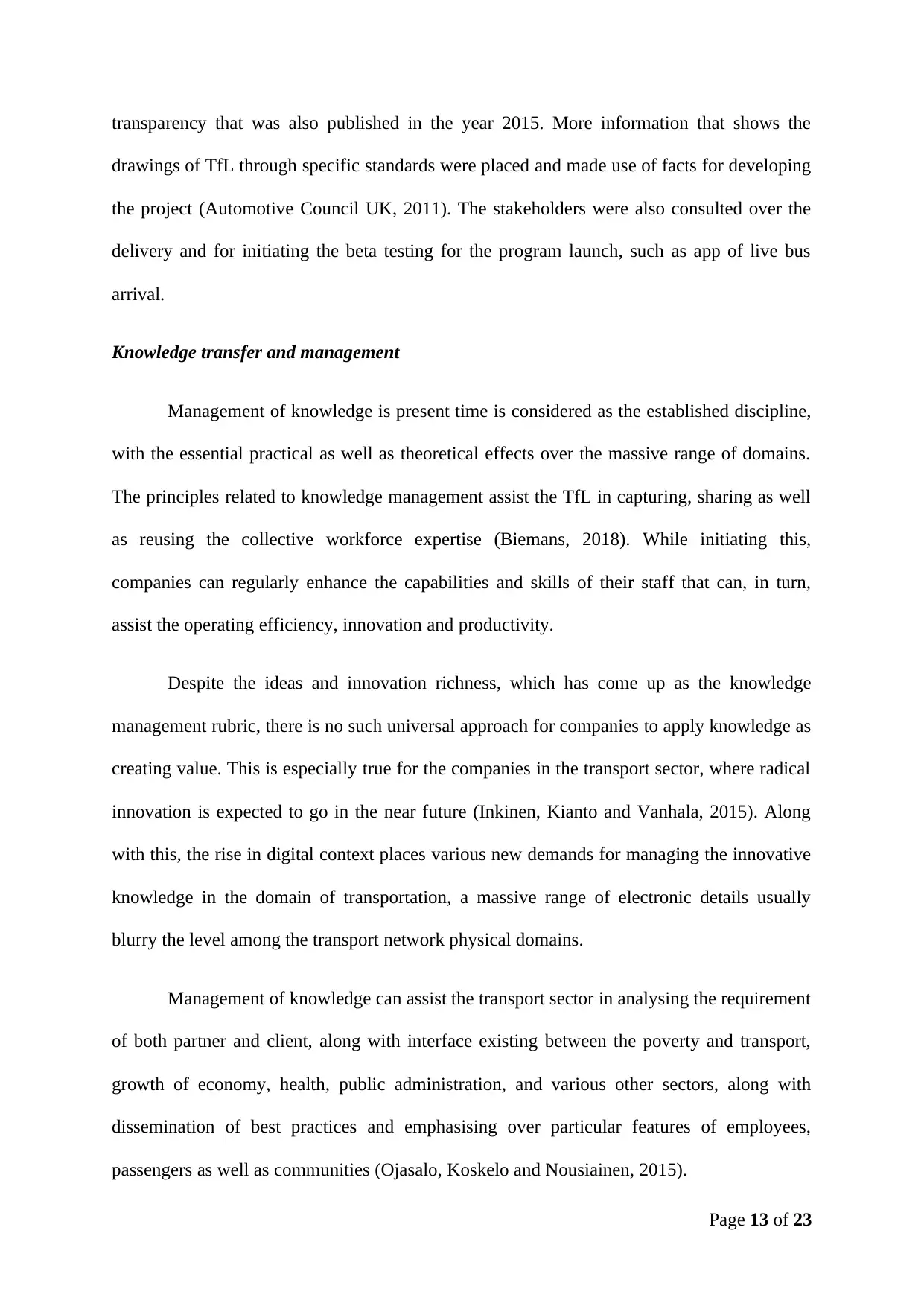
transparency that was also published in the year 2015. More information that shows the
drawings of TfL through specific standards were placed and made use of facts for developing
the project (Automotive Council UK, 2011). The stakeholders were also consulted over the
delivery and for initiating the beta testing for the program launch, such as app of live bus
arrival.
Knowledge transfer and management
Management of knowledge is present time is considered as the established discipline,
with the essential practical as well as theoretical effects over the massive range of domains.
The principles related to knowledge management assist the TfL in capturing, sharing as well
as reusing the collective workforce expertise (Biemans, 2018). While initiating this,
companies can regularly enhance the capabilities and skills of their staff that can, in turn,
assist the operating efficiency, innovation and productivity.
Despite the ideas and innovation richness, which has come up as the knowledge
management rubric, there is no such universal approach for companies to apply knowledge as
creating value. This is especially true for the companies in the transport sector, where radical
innovation is expected to go in the near future (Inkinen, Kianto and Vanhala, 2015). Along
with this, the rise in digital context places various new demands for managing the innovative
knowledge in the domain of transportation, a massive range of electronic details usually
blurry the level among the transport network physical domains.
Management of knowledge can assist the transport sector in analysing the requirement
of both partner and client, along with interface existing between the poverty and transport,
growth of economy, health, public administration, and various other sectors, along with
dissemination of best practices and emphasising over particular features of employees,
passengers as well as communities (Ojasalo, Koskelo and Nousiainen, 2015).
Page 13 of 23
drawings of TfL through specific standards were placed and made use of facts for developing
the project (Automotive Council UK, 2011). The stakeholders were also consulted over the
delivery and for initiating the beta testing for the program launch, such as app of live bus
arrival.
Knowledge transfer and management
Management of knowledge is present time is considered as the established discipline,
with the essential practical as well as theoretical effects over the massive range of domains.
The principles related to knowledge management assist the TfL in capturing, sharing as well
as reusing the collective workforce expertise (Biemans, 2018). While initiating this,
companies can regularly enhance the capabilities and skills of their staff that can, in turn,
assist the operating efficiency, innovation and productivity.
Despite the ideas and innovation richness, which has come up as the knowledge
management rubric, there is no such universal approach for companies to apply knowledge as
creating value. This is especially true for the companies in the transport sector, where radical
innovation is expected to go in the near future (Inkinen, Kianto and Vanhala, 2015). Along
with this, the rise in digital context places various new demands for managing the innovative
knowledge in the domain of transportation, a massive range of electronic details usually
blurry the level among the transport network physical domains.
Management of knowledge can assist the transport sector in analysing the requirement
of both partner and client, along with interface existing between the poverty and transport,
growth of economy, health, public administration, and various other sectors, along with
dissemination of best practices and emphasising over particular features of employees,
passengers as well as communities (Ojasalo, Koskelo and Nousiainen, 2015).
Page 13 of 23
Secure Best Marks with AI Grader
Need help grading? Try our AI Grader for instant feedback on your assignments.

TfL page of knowledge sharing and learning
The TfL page offers information about the work that a team of urban design do to
share the knowledge of the company and their best practices with the support of both internal
and external stakeholders. Below is the work and how actually the team assist its customers.
Urban realm value- the team of TfL urban design-build the tool, which can easily measure the
monetary advantages of investing the urban realm of high quality.
New London Architecture- the team of urban design, is accountable for managing the
relationship between New London Architecture and TfL (Randhawa and Scerri, 2015). It
helps in making sure that TfL will showcase the current innovative design and take part in the
events, exhibition and talks.
Training events at urban design London- this team is highly accountable for transferring or
sharing the knowledge as well as UDL best practices in courses and seminars.
Change management issues and strategies for overcoming possible resistance to change
Change drivers at TfL
Change drivers In context of Transport for London (TfL)
Organizational Integrate and restructure the various
companies
Technology Mobile devices, future tickets and Wi-Fi
station
Development of capability Project and change management, leadership
as well as commercial
Page 14 of 23
The TfL page offers information about the work that a team of urban design do to
share the knowledge of the company and their best practices with the support of both internal
and external stakeholders. Below is the work and how actually the team assist its customers.
Urban realm value- the team of TfL urban design-build the tool, which can easily measure the
monetary advantages of investing the urban realm of high quality.
New London Architecture- the team of urban design, is accountable for managing the
relationship between New London Architecture and TfL (Randhawa and Scerri, 2015). It
helps in making sure that TfL will showcase the current innovative design and take part in the
events, exhibition and talks.
Training events at urban design London- this team is highly accountable for transferring or
sharing the knowledge as well as UDL best practices in courses and seminars.
Change management issues and strategies for overcoming possible resistance to change
Change drivers at TfL
Change drivers In context of Transport for London (TfL)
Organizational Integrate and restructure the various
companies
Technology Mobile devices, future tickets and Wi-Fi
station
Development of capability Project and change management, leadership
as well as commercial
Page 14 of 23
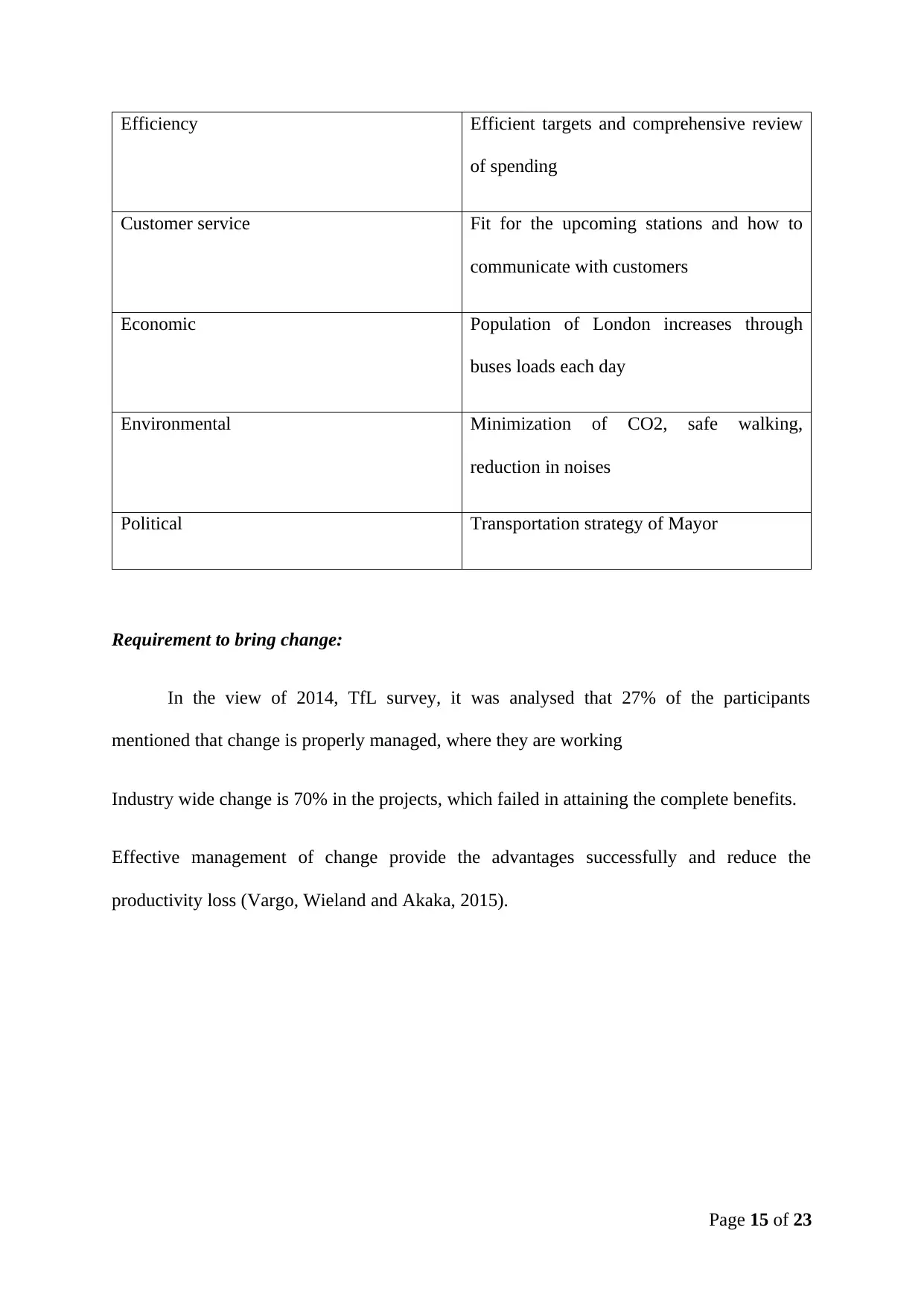
Efficiency Efficient targets and comprehensive review
of spending
Customer service Fit for the upcoming stations and how to
communicate with customers
Economic Population of London increases through
buses loads each day
Environmental Minimization of CO2, safe walking,
reduction in noises
Political Transportation strategy of Mayor
Requirement to bring change:
In the view of 2014, TfL survey, it was analysed that 27% of the participants
mentioned that change is properly managed, where they are working
Industry wide change is 70% in the projects, which failed in attaining the complete benefits.
Effective management of change provide the advantages successfully and reduce the
productivity loss (Vargo, Wieland and Akaka, 2015).
Page 15 of 23
of spending
Customer service Fit for the upcoming stations and how to
communicate with customers
Economic Population of London increases through
buses loads each day
Environmental Minimization of CO2, safe walking,
reduction in noises
Political Transportation strategy of Mayor
Requirement to bring change:
In the view of 2014, TfL survey, it was analysed that 27% of the participants
mentioned that change is properly managed, where they are working
Industry wide change is 70% in the projects, which failed in attaining the complete benefits.
Effective management of change provide the advantages successfully and reduce the
productivity loss (Vargo, Wieland and Akaka, 2015).
Page 15 of 23
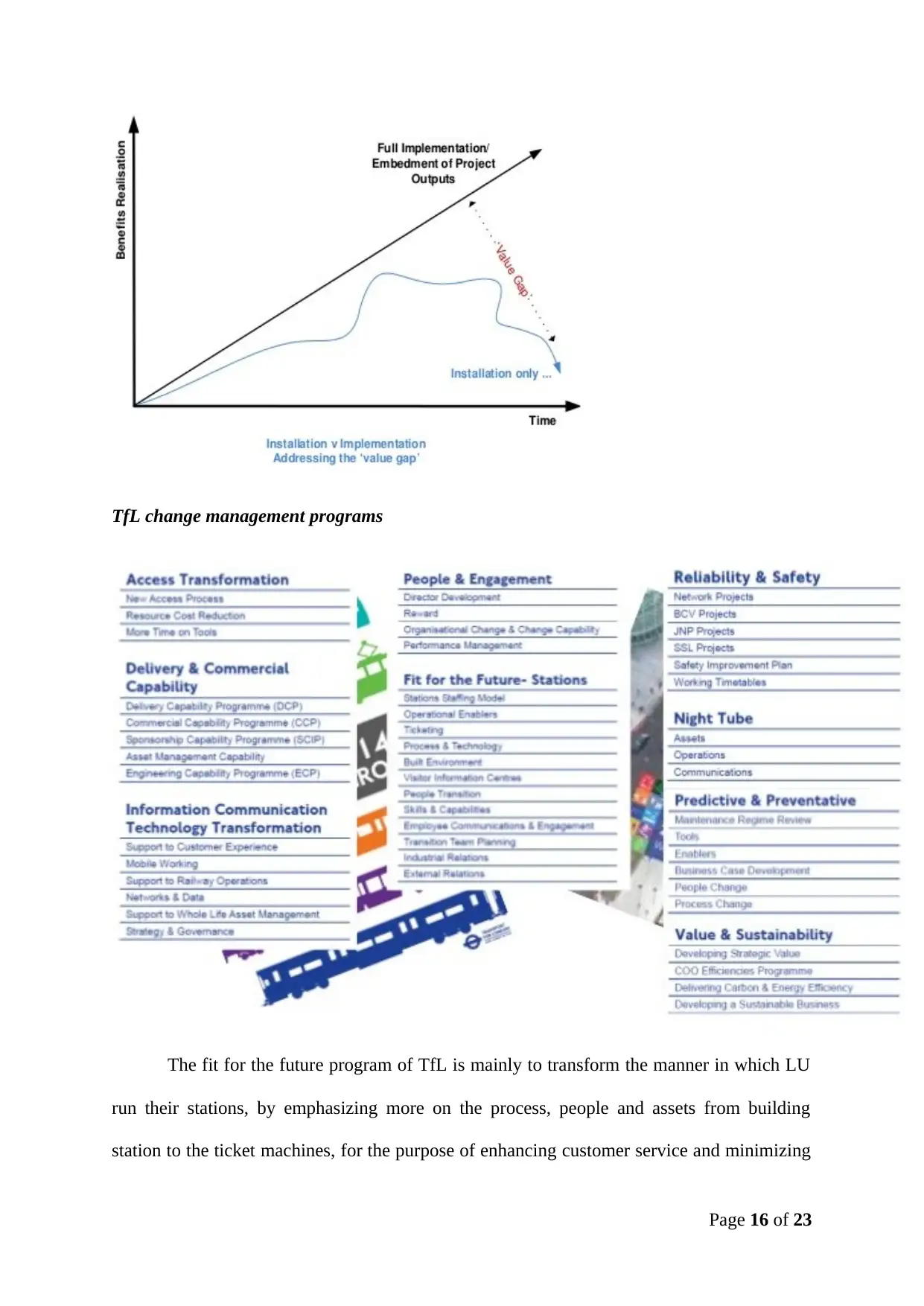
TfL change management programs
The fit for the future program of TfL is mainly to transform the manner in which LU
run their stations, by emphasizing more on the process, people and assets from building
station to the ticket machines, for the purpose of enhancing customer service and minimizing
Page 16 of 23
The fit for the future program of TfL is mainly to transform the manner in which LU
run their stations, by emphasizing more on the process, people and assets from building
station to the ticket machines, for the purpose of enhancing customer service and minimizing
Page 16 of 23
Paraphrase This Document
Need a fresh take? Get an instant paraphrase of this document with our AI Paraphraser
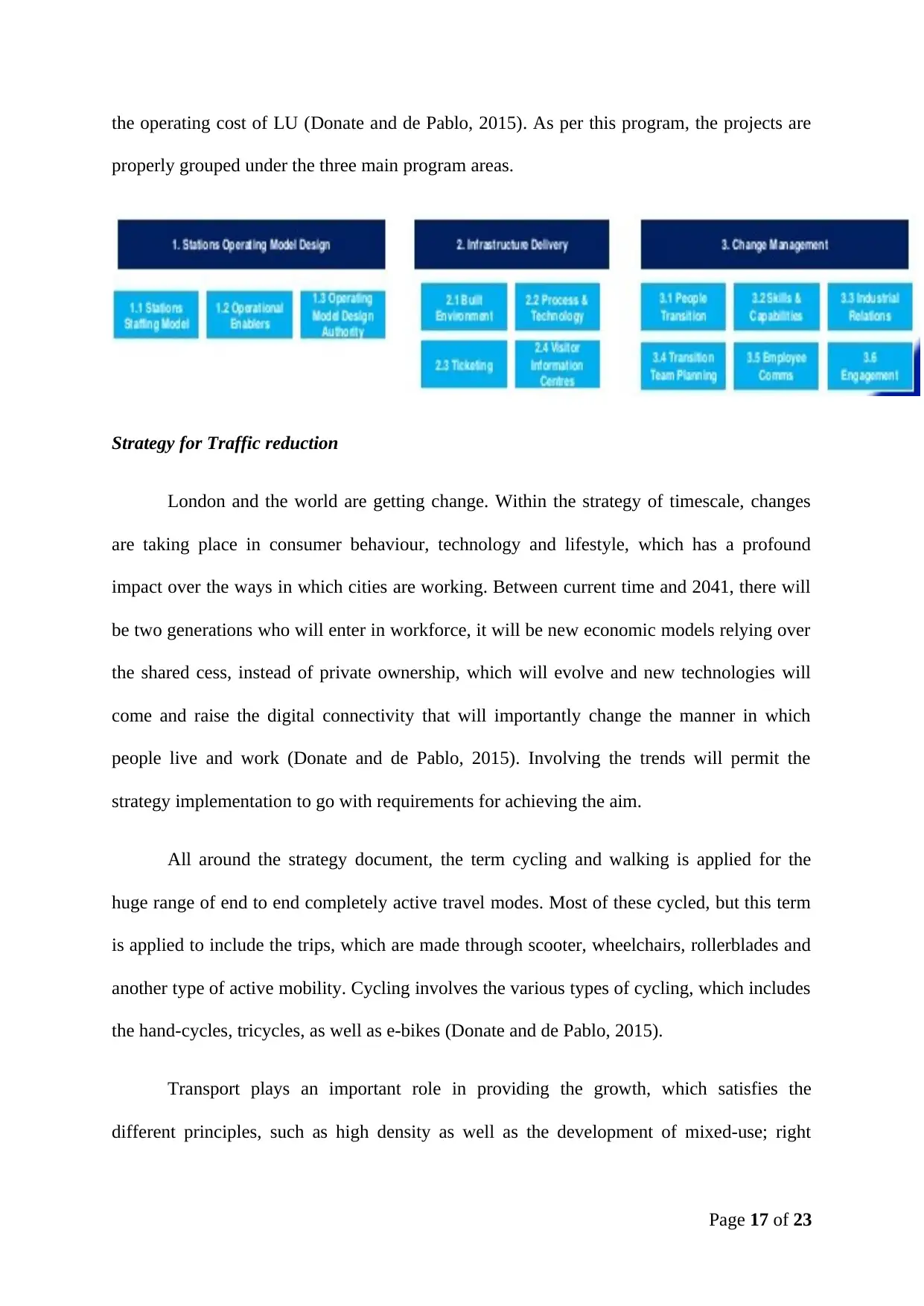
the operating cost of LU (Donate and de Pablo, 2015). As per this program, the projects are
properly grouped under the three main program areas.
Strategy for Traffic reduction
London and the world are getting change. Within the strategy of timescale, changes
are taking place in consumer behaviour, technology and lifestyle, which has a profound
impact over the ways in which cities are working. Between current time and 2041, there will
be two generations who will enter in workforce, it will be new economic models relying over
the shared cess, instead of private ownership, which will evolve and new technologies will
come and raise the digital connectivity that will importantly change the manner in which
people live and work (Donate and de Pablo, 2015). Involving the trends will permit the
strategy implementation to go with requirements for achieving the aim.
All around the strategy document, the term cycling and walking is applied for the
huge range of end to end completely active travel modes. Most of these cycled, but this term
is applied to include the trips, which are made through scooter, wheelchairs, rollerblades and
another type of active mobility. Cycling involves the various types of cycling, which includes
the hand-cycles, tricycles, as well as e-bikes (Donate and de Pablo, 2015).
Transport plays an important role in providing the growth, which satisfies the
different principles, such as high density as well as the development of mixed-use; right
Page 17 of 23
properly grouped under the three main program areas.
Strategy for Traffic reduction
London and the world are getting change. Within the strategy of timescale, changes
are taking place in consumer behaviour, technology and lifestyle, which has a profound
impact over the ways in which cities are working. Between current time and 2041, there will
be two generations who will enter in workforce, it will be new economic models relying over
the shared cess, instead of private ownership, which will evolve and new technologies will
come and raise the digital connectivity that will importantly change the manner in which
people live and work (Donate and de Pablo, 2015). Involving the trends will permit the
strategy implementation to go with requirements for achieving the aim.
All around the strategy document, the term cycling and walking is applied for the
huge range of end to end completely active travel modes. Most of these cycled, but this term
is applied to include the trips, which are made through scooter, wheelchairs, rollerblades and
another type of active mobility. Cycling involves the various types of cycling, which includes
the hand-cycles, tricycles, as well as e-bikes (Donate and de Pablo, 2015).
Transport plays an important role in providing the growth, which satisfies the
different principles, such as high density as well as the development of mixed-use; right
Page 17 of 23

public transport access; the individual choice to cycle or walk; accessible designs; car-lite
areas, effective freight and carbon-free travel (Donate and de Pablo, 2015).
Organisational Culture, Climate, Leadership and culture
Leadership
TfL works in partnership with the t-three, for offering the employees training days to
50,000; 1:1 hour of coaching, along with online learning hours of 1300. They also include the
action learning teams of 30 members that drive the enhancement for sustaining the changes
and enhancing the performance of the business (Donate and de Pablo, 2015).
It is analysed that 100% of the TfL area managers are given coaching for building the
capability of important areas of people management. There are around 170 leaders who are
given 2-day coach workshop for getting equipped with the coach skills for direct reports and
for the purpose of embedding the culture of coaching (Goffin and Mitchell, 2016). In the year
2017, the TfL programme was given various awards, which includes the best learning and
development strategy, best leadership development programme, as well as the best business
culture award for learning.
Culture
In the past years, TfL records have offered important reminders on how the
organisation should bring the changes, and make the correct understanding of the social
history of the company. Due to the cultural values of the company, the company give high
emphasis on everyone enjoyment and use. The corporate archives of TfL are highly
accountable for safeguarding the TfL corporate memory, and predecessor organisation. The
organisational culture gathers and preserve historic and modern records and also include
100,000 products since the 17th century to date (Dodgson, 2018). The company also gather
Page 18 of 23
areas, effective freight and carbon-free travel (Donate and de Pablo, 2015).
Organisational Culture, Climate, Leadership and culture
Leadership
TfL works in partnership with the t-three, for offering the employees training days to
50,000; 1:1 hour of coaching, along with online learning hours of 1300. They also include the
action learning teams of 30 members that drive the enhancement for sustaining the changes
and enhancing the performance of the business (Donate and de Pablo, 2015).
It is analysed that 100% of the TfL area managers are given coaching for building the
capability of important areas of people management. There are around 170 leaders who are
given 2-day coach workshop for getting equipped with the coach skills for direct reports and
for the purpose of embedding the culture of coaching (Goffin and Mitchell, 2016). In the year
2017, the TfL programme was given various awards, which includes the best learning and
development strategy, best leadership development programme, as well as the best business
culture award for learning.
Culture
In the past years, TfL records have offered important reminders on how the
organisation should bring the changes, and make the correct understanding of the social
history of the company. Due to the cultural values of the company, the company give high
emphasis on everyone enjoyment and use. The corporate archives of TfL are highly
accountable for safeguarding the TfL corporate memory, and predecessor organisation. The
organisational culture gathers and preserve historic and modern records and also include
100,000 products since the 17th century to date (Dodgson, 2018). The company also gather
Page 18 of 23
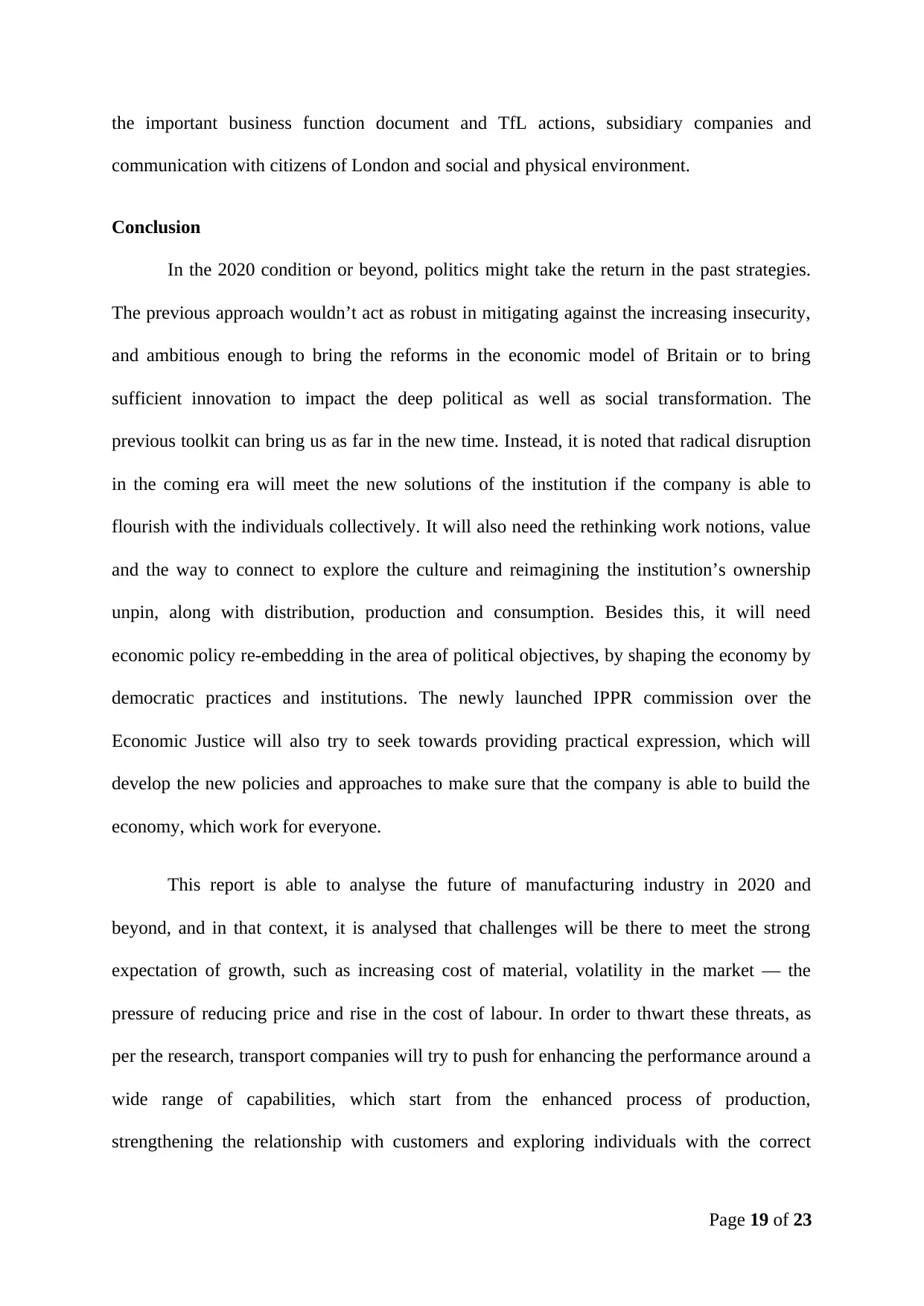
the important business function document and TfL actions, subsidiary companies and
communication with citizens of London and social and physical environment.
Conclusion
In the 2020 condition or beyond, politics might take the return in the past strategies.
The previous approach wouldn’t act as robust in mitigating against the increasing insecurity,
and ambitious enough to bring the reforms in the economic model of Britain or to bring
sufficient innovation to impact the deep political as well as social transformation. The
previous toolkit can bring us as far in the new time. Instead, it is noted that radical disruption
in the coming era will meet the new solutions of the institution if the company is able to
flourish with the individuals collectively. It will also need the rethinking work notions, value
and the way to connect to explore the culture and reimagining the institution’s ownership
unpin, along with distribution, production and consumption. Besides this, it will need
economic policy re-embedding in the area of political objectives, by shaping the economy by
democratic practices and institutions. The newly launched IPPR commission over the
Economic Justice will also try to seek towards providing practical expression, which will
develop the new policies and approaches to make sure that the company is able to build the
economy, which work for everyone.
This report is able to analyse the future of manufacturing industry in 2020 and
beyond, and in that context, it is analysed that challenges will be there to meet the strong
expectation of growth, such as increasing cost of material, volatility in the market — the
pressure of reducing price and rise in the cost of labour. In order to thwart these threats, as
per the research, transport companies will try to push for enhancing the performance around a
wide range of capabilities, which start from the enhanced process of production,
strengthening the relationship with customers and exploring individuals with the correct
Page 19 of 23
communication with citizens of London and social and physical environment.
Conclusion
In the 2020 condition or beyond, politics might take the return in the past strategies.
The previous approach wouldn’t act as robust in mitigating against the increasing insecurity,
and ambitious enough to bring the reforms in the economic model of Britain or to bring
sufficient innovation to impact the deep political as well as social transformation. The
previous toolkit can bring us as far in the new time. Instead, it is noted that radical disruption
in the coming era will meet the new solutions of the institution if the company is able to
flourish with the individuals collectively. It will also need the rethinking work notions, value
and the way to connect to explore the culture and reimagining the institution’s ownership
unpin, along with distribution, production and consumption. Besides this, it will need
economic policy re-embedding in the area of political objectives, by shaping the economy by
democratic practices and institutions. The newly launched IPPR commission over the
Economic Justice will also try to seek towards providing practical expression, which will
develop the new policies and approaches to make sure that the company is able to build the
economy, which work for everyone.
This report is able to analyse the future of manufacturing industry in 2020 and
beyond, and in that context, it is analysed that challenges will be there to meet the strong
expectation of growth, such as increasing cost of material, volatility in the market — the
pressure of reducing price and rise in the cost of labour. In order to thwart these threats, as
per the research, transport companies will try to push for enhancing the performance around a
wide range of capabilities, which start from the enhanced process of production,
strengthening the relationship with customers and exploring individuals with the correct
Page 19 of 23
Secure Best Marks with AI Grader
Need help grading? Try our AI Grader for instant feedback on your assignments.

experience and skills. For achieving the growth targets, manufacturers will invest in the area
that can enhance productivity and give speed response. It is analysed that leaders of TfL will
prioritise the investments too easy to collaboration with both suppliers and customers,
collecting market intelligence as well as streamline the communication with customers..
Page 20 of 23
that can enhance productivity and give speed response. It is analysed that leaders of TfL will
prioritise the investments too easy to collaboration with both suppliers and customers,
collecting market intelligence as well as streamline the communication with customers..
Page 20 of 23

References
Automotive Council UK. (2011). Intelligent Mobility: A National Need? [Online]. Available
at:
http://www.automotivecouncil.co.uk/wp-content/uploads/2011/12/ITS_Report_15_11_11.pdf
[Accessed on 12 June 2019].
Beevers, S.D., Carslaw, D.C., Dajnak, D., Stewart, G.B., Williams, M.L., Fussell, J.C. and
Kelly, F.J. (2016). Traffic management strategies for emissions reduction: recent experience
in London. Energy and Emission Control Technologies, 4, pp.27-39.
Biemans, W. (2018). Managing innovation within networks. Routledge.
Christensen, C.M, Raynor, M.E. and McDonald, R. (2015). ‘What is disruptive innovation?’
Harvard Business Review, 93(12), pp. 44–53.
Dodgson, M. (2018). Technological collaboration in industry: strategy, policy and
internationalization in innovation. Routledge.
Donate, M.J. and de Pablo, J.D.S. (2015). The role of knowledge-oriented leadership in
knowledge management practices and innovation. Journal of Business Research, 68(2),
pp.360-370.
Goffin, K. and Mitchell, R. (2016). Innovation management: effective strategy and
implementation. Macmillan International Higher Education.
Inkinen, H.T., Kianto, A. and Vanhala, M. (2015). Knowledge management practices and
innovation performance in Finland. Baltic Journal of Management, 10(4), pp.432-455.
International Transport Forum [ITF]. (2016). Shared Mobility: Innovation for Liveable
Cities, Corporate Partnership Board report. [Online]. Available at:
http://www.itf-oecd.org/sites/default/files/docs/sharedmobility-liveable-cities.pdf [Accessed
on 12 June 2019].
Page 21 of 23
Automotive Council UK. (2011). Intelligent Mobility: A National Need? [Online]. Available
at:
http://www.automotivecouncil.co.uk/wp-content/uploads/2011/12/ITS_Report_15_11_11.pdf
[Accessed on 12 June 2019].
Beevers, S.D., Carslaw, D.C., Dajnak, D., Stewart, G.B., Williams, M.L., Fussell, J.C. and
Kelly, F.J. (2016). Traffic management strategies for emissions reduction: recent experience
in London. Energy and Emission Control Technologies, 4, pp.27-39.
Biemans, W. (2018). Managing innovation within networks. Routledge.
Christensen, C.M, Raynor, M.E. and McDonald, R. (2015). ‘What is disruptive innovation?’
Harvard Business Review, 93(12), pp. 44–53.
Dodgson, M. (2018). Technological collaboration in industry: strategy, policy and
internationalization in innovation. Routledge.
Donate, M.J. and de Pablo, J.D.S. (2015). The role of knowledge-oriented leadership in
knowledge management practices and innovation. Journal of Business Research, 68(2),
pp.360-370.
Goffin, K. and Mitchell, R. (2016). Innovation management: effective strategy and
implementation. Macmillan International Higher Education.
Inkinen, H.T., Kianto, A. and Vanhala, M. (2015). Knowledge management practices and
innovation performance in Finland. Baltic Journal of Management, 10(4), pp.432-455.
International Transport Forum [ITF]. (2016). Shared Mobility: Innovation for Liveable
Cities, Corporate Partnership Board report. [Online]. Available at:
http://www.itf-oecd.org/sites/default/files/docs/sharedmobility-liveable-cities.pdf [Accessed
on 12 June 2019].
Page 21 of 23
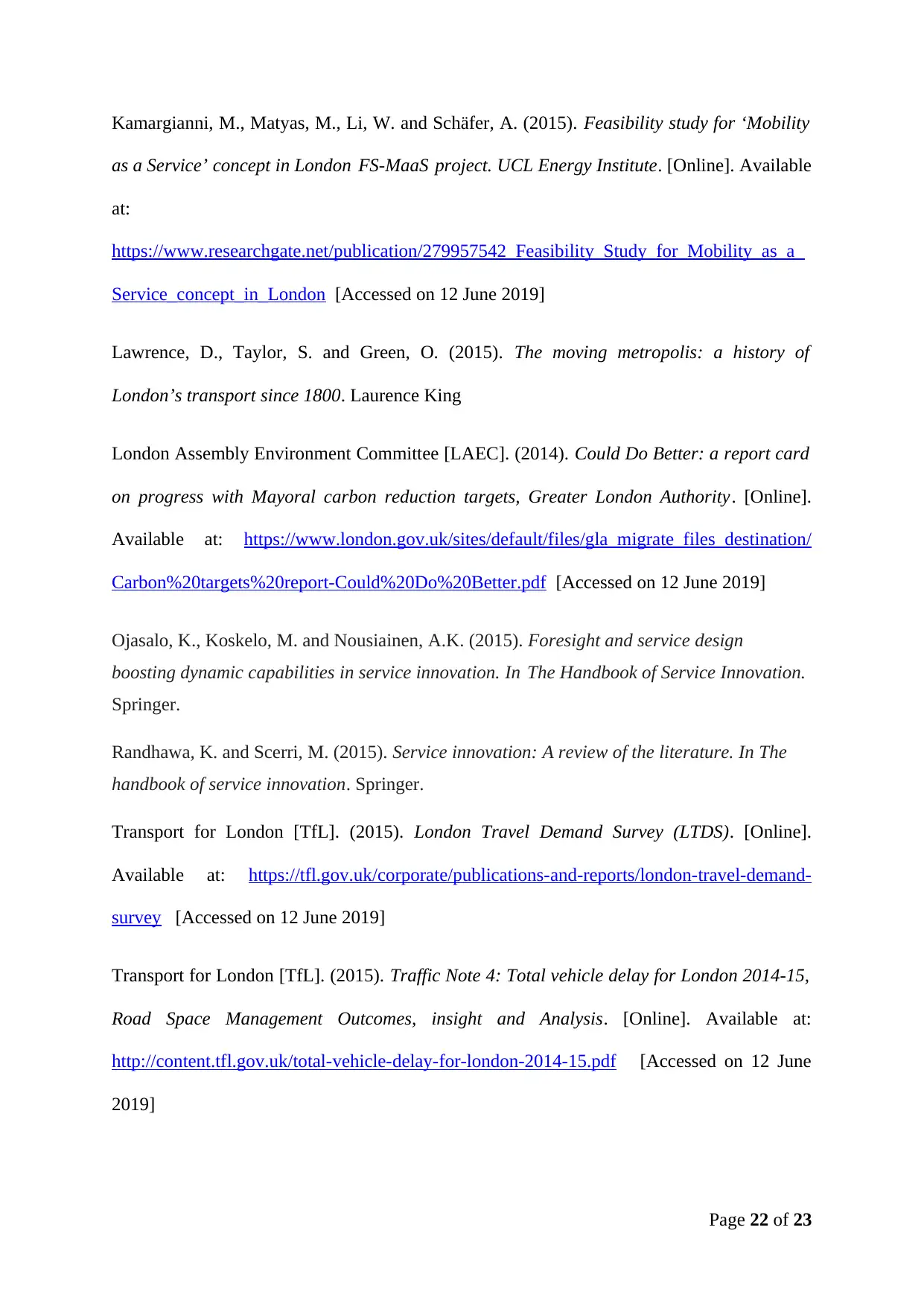
Kamargianni, M., Matyas, M., Li, W. and Schäfer, A. (2015). Feasibility study for ‘Mobility
as a Service’ concept in London FS-MaaS project. UCL Energy Institute. [Online]. Available
at:
https://www.researchgate.net/publication/279957542_Feasibility_Study_for_Mobility_as_a_
Service_concept_in_London [Accessed on 12 June 2019]
Lawrence, D., Taylor, S. and Green, O. (2015). The moving metropolis: a history of
London’s transport since 1800. Laurence King
London Assembly Environment Committee [LAEC]. (2014). Could Do Better: a report card
on progress with Mayoral carbon reduction targets, Greater London Authority. [Online].
Available at: https://www.london.gov.uk/sites/default/files/gla_migrate_files_destination/
Carbon%20targets%20report-Could%20Do%20Better.pdf [Accessed on 12 June 2019]
Ojasalo, K., Koskelo, M. and Nousiainen, A.K. (2015). Foresight and service design
boosting dynamic capabilities in service innovation. In The Handbook of Service Innovation.
Springer.
Randhawa, K. and Scerri, M. (2015). Service innovation: A review of the literature. In The
handbook of service innovation. Springer.
Transport for London [TfL]. (2015). London Travel Demand Survey (LTDS). [Online].
Available at: https://tfl.gov.uk/corporate/publications-and-reports/london-travel-demand-
survey [Accessed on 12 June 2019]
Transport for London [TfL]. (2015). Traffic Note 4: Total vehicle delay for London 2014-15,
Road Space Management Outcomes, insight and Analysis. [Online]. Available at:
http://content.tfl.gov.uk/total-vehicle-delay-for-london-2014-15.pdf [Accessed on 12 June
2019]
Page 22 of 23
as a Service’ concept in London FS-MaaS project. UCL Energy Institute. [Online]. Available
at:
https://www.researchgate.net/publication/279957542_Feasibility_Study_for_Mobility_as_a_
Service_concept_in_London [Accessed on 12 June 2019]
Lawrence, D., Taylor, S. and Green, O. (2015). The moving metropolis: a history of
London’s transport since 1800. Laurence King
London Assembly Environment Committee [LAEC]. (2014). Could Do Better: a report card
on progress with Mayoral carbon reduction targets, Greater London Authority. [Online].
Available at: https://www.london.gov.uk/sites/default/files/gla_migrate_files_destination/
Carbon%20targets%20report-Could%20Do%20Better.pdf [Accessed on 12 June 2019]
Ojasalo, K., Koskelo, M. and Nousiainen, A.K. (2015). Foresight and service design
boosting dynamic capabilities in service innovation. In The Handbook of Service Innovation.
Springer.
Randhawa, K. and Scerri, M. (2015). Service innovation: A review of the literature. In The
handbook of service innovation. Springer.
Transport for London [TfL]. (2015). London Travel Demand Survey (LTDS). [Online].
Available at: https://tfl.gov.uk/corporate/publications-and-reports/london-travel-demand-
survey [Accessed on 12 June 2019]
Transport for London [TfL]. (2015). Traffic Note 4: Total vehicle delay for London 2014-15,
Road Space Management Outcomes, insight and Analysis. [Online]. Available at:
http://content.tfl.gov.uk/total-vehicle-delay-for-london-2014-15.pdf [Accessed on 12 June
2019]
Page 22 of 23
Paraphrase This Document
Need a fresh take? Get an instant paraphrase of this document with our AI Paraphraser
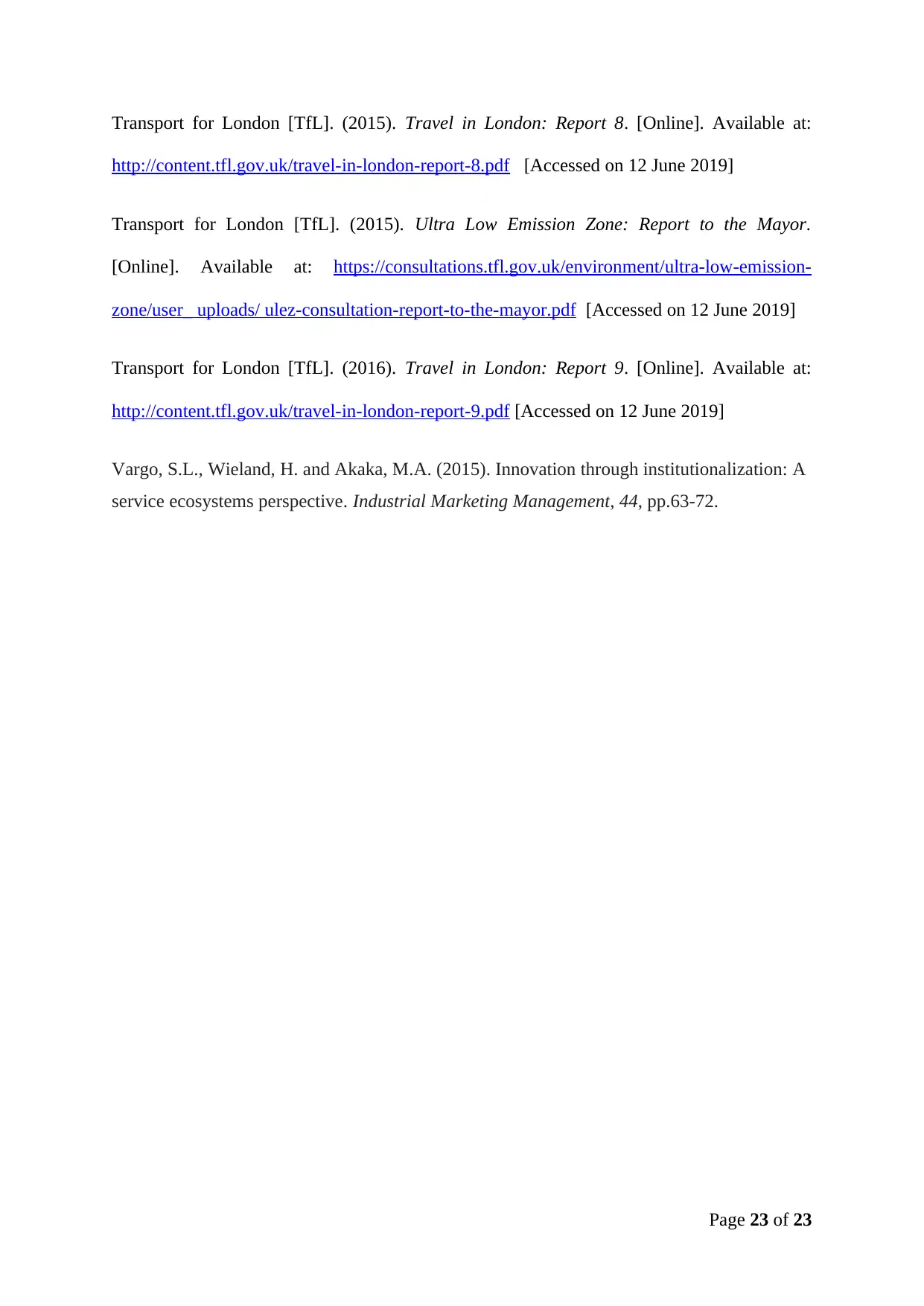
Transport for London [TfL]. (2015). Travel in London: Report 8. [Online]. Available at:
http://content.tfl.gov.uk/travel-in-london-report-8.pdf [Accessed on 12 June 2019]
Transport for London [TfL]. (2015). Ultra Low Emission Zone: Report to the Mayor.
[Online]. Available at: https://consultations.tfl.gov.uk/environment/ultra-low-emission-
zone/user_ uploads/ ulez-consultation-report-to-the-mayor.pdf [Accessed on 12 June 2019]
Transport for London [TfL]. (2016). Travel in London: Report 9. [Online]. Available at:
http://content.tfl.gov.uk/travel-in-london-report-9.pdf [Accessed on 12 June 2019]
Vargo, S.L., Wieland, H. and Akaka, M.A. (2015). Innovation through institutionalization: A
service ecosystems perspective. Industrial Marketing Management, 44, pp.63-72.
Page 23 of 23
http://content.tfl.gov.uk/travel-in-london-report-8.pdf [Accessed on 12 June 2019]
Transport for London [TfL]. (2015). Ultra Low Emission Zone: Report to the Mayor.
[Online]. Available at: https://consultations.tfl.gov.uk/environment/ultra-low-emission-
zone/user_ uploads/ ulez-consultation-report-to-the-mayor.pdf [Accessed on 12 June 2019]
Transport for London [TfL]. (2016). Travel in London: Report 9. [Online]. Available at:
http://content.tfl.gov.uk/travel-in-london-report-9.pdf [Accessed on 12 June 2019]
Vargo, S.L., Wieland, H. and Akaka, M.A. (2015). Innovation through institutionalization: A
service ecosystems perspective. Industrial Marketing Management, 44, pp.63-72.
Page 23 of 23
1 out of 23
![[object Object]](/_next/static/media/star-bottom.7253800d.svg)


